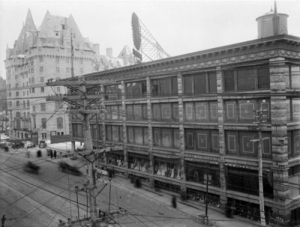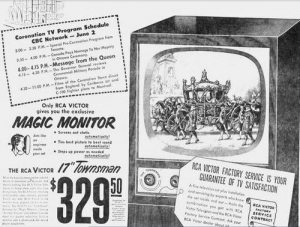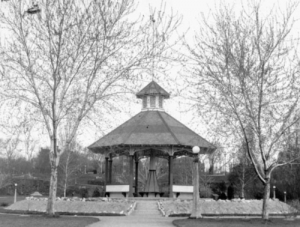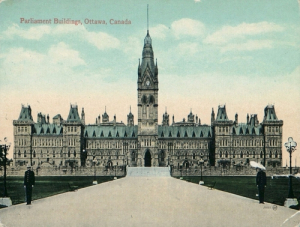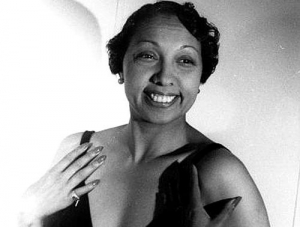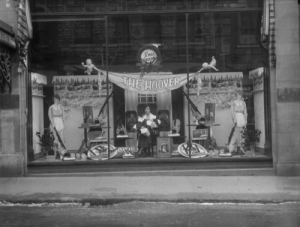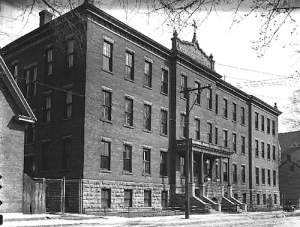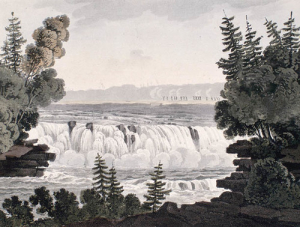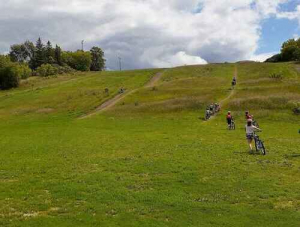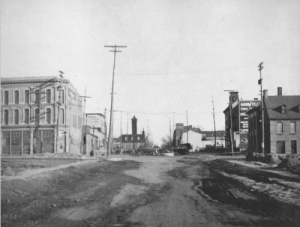James Powell
The Rise and Fall of the Daly Building
14 June 1905
One of the greatest heritage battles in Ottawa’s history was fought over the future of the Daly Building, a multi-storey, former department store cum government office building located in the block bounded by Mackenzie Avenue, Rideau Street and Sussex Avenue. The architectural and historic merits of the building, constructed in what is known as the “Chicago style,” were debated ad nauseam for years if not decades in Ottawa’s newspapers, at City Hall, and at the National Capital Commission. While all could agree that something had to be done with the aging building, what that something was sharply divided Ottawa residents. As it turned out, the building, which was vacated by its last tenants in 1978, was left empty for thirteen years as the federal government, the owner of the property, dithered. It was hastily demolished in 1991, amidst a huge outcry, after a renovation attempt fell through. Paralleling what happened with LeBreton Flatts, the land was then left fallow for more than a decade. After many different development concepts were advanced and discarded, the government finally leased the property to Claridge Homes for an up-scale condominium building that opened in 2005.
The edifice which was to become known as the Daly Building, was built in 1904-05 by the Clemow Estate, under the supervision of Mr. William F. Powell who managed the Estate’s business affairs. Powell had originally hoped to build a hotel on the site. (This was before the Château Laurier was constructed across the street.) But when his hotel plans fell through, Powell negotiated a deal with Thomas Lindsay, a prominent Ottawa merchant who owned T. Lindsay Company, a department store on Wellington Street, and Larose & Company on Rideau Street. Under the agreement, the Clemow Estate would build a modern, five-storey, department store building that Thomas Lindsay would lease.
In preparation for the project, Powell travelled to New York on a fact-finding mission about the large department stores of that city. He then engaged Moses C. Edey as architect. Edey was no stranger to Ottawa. Born in Wyman, Quebec, the Edey family had come to the Hull area in 1805 with Philemon Wright. Edey was the architect of the Aberdeen Pavilion at Lansdowne Park completed in 1898. For the new department store, Edey chose what was for the time a daring new form of architecture that relied on a steel and stone external framework that permitted the installation of large, plate-glass windows. There was so much external glass that the Evening Journal commented that the building should be called a “crystal palace.” There were no interior walls, allowing maximum flexibility to organize the space. Instead, the floors were supported by 32 steel columns clad in Portland cement. This “Chicago School” form of construction is considered to be the forerunner of the modern glass and steel office tower.
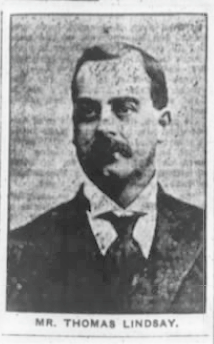 Thomas Lindsay, builder of what later would be known as the Daly Building, Ottawa Evening Journal, 15 June 1905.Ground was broken for the five-storey building (four storeys on the Mackenzie Avenue since the edifice was constructed on a slope) in the summer of 1904, and was completed a year later. The new Thomas Lindsay Company department store opened its doors for business on 14 June 1905.
Thomas Lindsay, builder of what later would be known as the Daly Building, Ottawa Evening Journal, 15 June 1905.Ground was broken for the five-storey building (four storeys on the Mackenzie Avenue since the edifice was constructed on a slope) in the summer of 1904, and was completed a year later. The new Thomas Lindsay Company department store opened its doors for business on 14 June 1905.
Thomas Lindsay, who had started the eponymous firm roughly fourteen years earlier at his Wellington Street location, was known for selling goods at low prices. His company was advertised as “The House of Bargains” and “the store where money has the greatest purchasing power.” But there was no stinting on the interior furnishings and fittings of his new department store. As well as having wide staircases, the store was serviced by three elevators, two for customers and one for freight. In addition to the natural lighting provided by the large plate glass windows, which were fitted with pivoting devices that permitted them to swivel open for easy cleaning and fresh air, the building was equipped with electric lighting. Around every other pillar on each floor was a large display table for goods. Every floor was serviced by a pneumatic tube, cash-carrying system, and had ladies’ and gentlemen’s toilets, all furnished with hot and cold running water. On the second floor overlooking Major Hill’s Park there was a large drawing room for visitors where they could go to sit, relax, read the latest magazines, or write letters. A ladies’ “retiring room” was off of this.
On opening day, only three floors were finished; the upper two floors were completed by the fall. On the ground floor, off of Sussex Street, there was the men’s and boy’s clothing departments, a grocery equipped with a three-compartment refrigerator, and a drug store. On the first floor (accessed through the Mackenzie Street entrance), were the ladies’ department, and a “small wares” department. There were offices the third floor. Home furnishings, carpets, and hardware were located on the upper two floors once they were completed.
In 1906, Thomas Lindsay Company bought the building, as well as an adjacent empty lot to the north of the original structure, and other nearby properties from the Clemow Estate for reportedly $350,000. Lindsay’s intention was to increase the floor space of the department store by adding two floors, as originally designed by the building’s architect, and by extending the building onto the empty lot. However, these plans were delayed, possibly due to Thomas Lindsay’s declining health. In 1909, Thomas Lindsay sold his controlling interest in the Thomas Lindsay Company to the Rea brothers of Toronto for $300,000; the business had become too much for him. He died shortly after the sale.
The Rea brothers had retail experience in Toronto, having sold a similar store there to Robert Simpson, the owner of Simpson’s Department Store. After a short delay, they changed the name of their new department store to the A.E. Rea Company. In 1913, they undertook the store’s expansion as originally envisage by Lindsay. Other changes included a shortened work week. No longer would employees start work at 7:30am. Instead there would be a nine-hour day beginning at 8.30am, running until 5:30pm. As well, a new money-back guarantee was introduced. Also changed was the advertising policy of the store. Thomas Lindsay had withdrawn all advertising from the Ottawa Citizen in early 1908 owing to the newspaper’s opposition to the City taking over the Metropolitan Company’s water power operations at Britannia. Lindsay, who was a major shareholder in the power company, favoured the sale. Lindsay’s ban on advertising in the Citizen was revoked when the Rea brothers purchased the store.
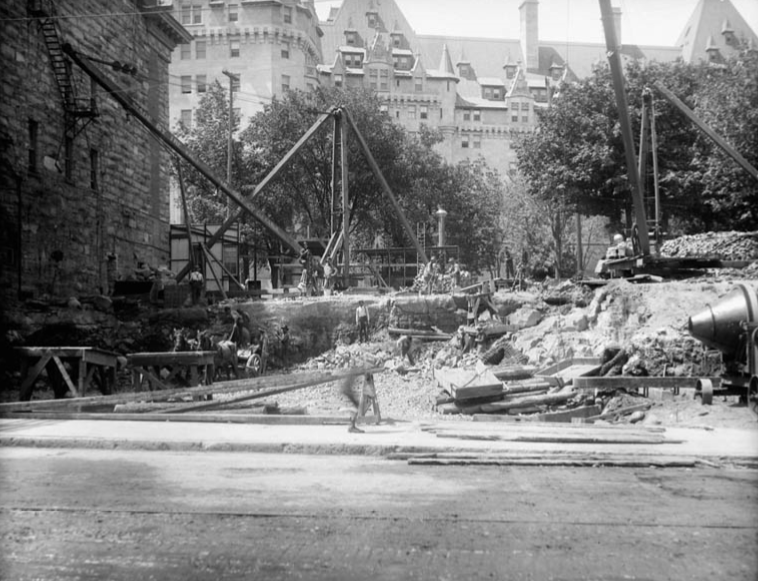 Construction of the Daly Building extension northward along Sussex Street. The Château Laurier Hotel is in the background, 1913, Library and Archives Canada, Topley Studios, ID #3410293.
Construction of the Daly Building extension northward along Sussex Street. The Château Laurier Hotel is in the background, 1913, Library and Archives Canada, Topley Studios, ID #3410293.
In late 1917, the Rea brothers, who had overextended themselves, ran into financial difficulty. Liquidators were called in to settle their affairs with the stock and assets of the department store sold off at 40 cents on the dollar. The big department store passed into the hands of H. J. Daly who took over the business and ownership of the building in February 1918.
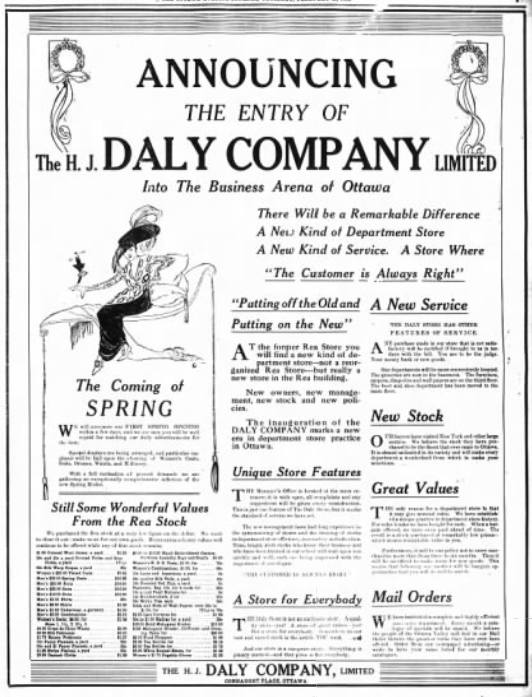 Advertisement that appeared in the Ottawa Journal 28 February, 1918.Oddly, for a building that bore his name for the rest of the century, Daly didn’t own it for very long—less than four years. In 1919, Daly moved his department store operations to a new store built on Sparks Street on a site previously occupied by the Arcade building (roughly where the CBC building is today) which had burnt down in a huge conflagration in December 1917. By mid-August 1919, the Daly Building was vacated and rented to the Federal Government which subsequently bought it for $1 million in late 1921. The H. J. Daly department store did not last long in its new Sparks Street location. It failed in early 1923.
Advertisement that appeared in the Ottawa Journal 28 February, 1918.Oddly, for a building that bore his name for the rest of the century, Daly didn’t own it for very long—less than four years. In 1919, Daly moved his department store operations to a new store built on Sparks Street on a site previously occupied by the Arcade building (roughly where the CBC building is today) which had burnt down in a huge conflagration in December 1917. By mid-August 1919, the Daly Building was vacated and rented to the Federal Government which subsequently bought it for $1 million in late 1921. The H. J. Daly department store did not last long in its new Sparks Street location. It failed in early 1923.
As for the Daly Building itself, it was the home of a variety of federal government departments over the next fifty plus years, starting with the Department of Health in 1919 and ending as the Customs and Excise training centre in 1978. Its last private-sector tenant was Ad Lib, a women’s clothing store.
Discussion about pulling down the building began in 1954 when Jacques Gréber, the noted French urban planner who advised the federal government on how to beautify the Capital, recommended replacing the Daly building with a three-floor parking garage with a park on top. His suggestion did not go over well with Mayor Charlotte Whitton. The Minister of Public Works announced that other departments needed the space and the idea quickly faded.
But by the late 1970s, the building was in poor condition. As well, past renovations, which included replacing the windows during the 1920s and the removal of the decorative cornice in 1964 over concerns that pieces might fall and hurt passing pedestrians, were not sympathetic to the original design. With lots of new federal office space just built in Hull, the Daly Building was surplus to requirements. The Department of Public Works announced that since it was not economic to renovate it, the building would be demolished in 1979.
This set off a huge fight between conservationists and demolishers within the federal government, architect associations, and the heritage community over the merits of the conserving the only example of “Chicago-style architecture” in the city. As the war of words raged, the building slowly deteriorated. On the side of saving the former department store were Ottawa mayor Marion Dewar, and Jean Pigott, for a time the Chair of the National Capital Commission in the mid-1980s. Heritage Ottawa and a dedicated lobby group called Friends of the Daly Building also called for its restoration. Others, however, applauded its demolition. Charles Lynch, the noted Canadian journalist, author, and one-time former governor of Heritage Ottawa called the Daly Building “an ugly duckling: a former failed department store, failed office building, and successful eyesore.” He opined that the structure offered nothing of note or of beauty, either outside or inside, and he would be “honoured to strike the first blow when the wreckers come.” Another commentator wrote that the “heritage movement risked “making a fool of itself by unwise support of an unworthy cause.” He argued that to spend millions to “create a museum for architects when the general population hated the building was a form of “elitism.”
The hammer finally came down in September 1991 when the National Capital Commission announced that it didn’t believe that a group of developers (Coopdev and its partner Duroc Enterprises) would be able to finish a planned $45 million renovation by September the following year owing to the developers’ inability to find a major tenant for the renovated structure. When Coopdev failed to pay its first $60,000 payment in monthly rent on its 66-year lease, the NCC fired the company. The Daly Building was hastily demolished just a few days later.
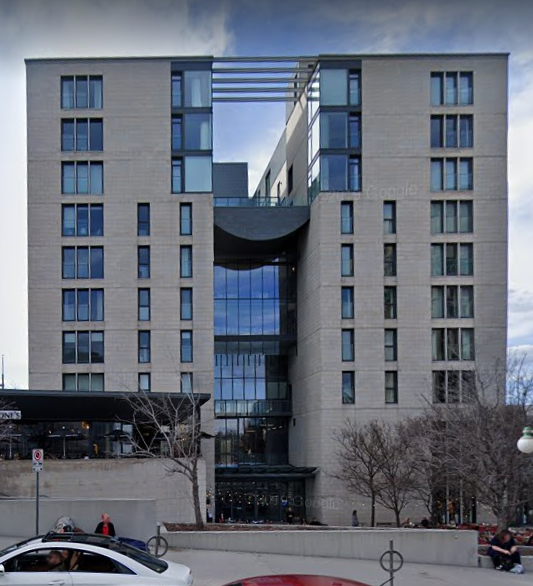 700 Sussex Street, site of the “Daly Building,” Google Maps, May 2019.Over the following fourteen years, suggestions came and went on what to do with the property. Should it be a park, a parking garage, or some new prestige project? One idea that gained some traction for a while was to build a performing arts centre to celebrate Canada’s Indigenous peoples. Noted Canadian architect, Douglas Cardinal, reportedly agreed to design the centre. The idea flopped. In the late 1990s, Gateway Development Corp. proposed building an upscale hotel on the site, with retail stores on the ground level, loft apartments, and, believe it or not, an underground aquarium. The proposal failed to receive the necessary financial backing and the project collapsed.
700 Sussex Street, site of the “Daly Building,” Google Maps, May 2019.Over the following fourteen years, suggestions came and went on what to do with the property. Should it be a park, a parking garage, or some new prestige project? One idea that gained some traction for a while was to build a performing arts centre to celebrate Canada’s Indigenous peoples. Noted Canadian architect, Douglas Cardinal, reportedly agreed to design the centre. The idea flopped. In the late 1990s, Gateway Development Corp. proposed building an upscale hotel on the site, with retail stores on the ground level, loft apartments, and, believe it or not, an underground aquarium. The proposal failed to receive the necessary financial backing and the project collapsed.
The NCC finally reached a deal with Claridge Homes and its president Bill Malhotra, under which the developer would lease the site for 66 years and build an eleven-storey condominium building with an open-air roof deck and garden on the eighth floor. The 70 luxury apartments ranged in size from roughly 1,000 to 2,300 square feet in size. The price for the one of the penthouse suites reportedly topped $1.75 million… and this was in 2002! Despite the eye-watering prices, 700 Sussex Drive proved to be a great success and quickly sold out.
While the old Daly department store is now long gone, its spirit is still with us. Dan Hanganu, the architect for the new condominium development, apparently drew his design inspiration from the old department store.
Sources:
Heritage Ottawa, Daly Building, https://heritageottawa.org/50years/daly-building.
Ottawa Citizen, 1905. “Clemow Estate,” 12 June.
——————, 1905. “Opening Of Ottawa’s New Palatial Store,” 10 June.
——————, 1905. “Congratulations,” 15 June.
——————, 1909. “Control May Change Hands,” 3 August.
——————, 1909. “The Lindsay Sale,” 7 August 1909.
——————, 1909. “Style Center Of Canada,” 18 August.
——————, 1909. “A Bit Of Local History,” 20 August.
——————, 1909. “Shorter Hours For Employes (sic),” 25 August.
——————, 1954. “Mayor Calls Greber Parking Plan Speculative Newspaper Story,’” 14 September.
——————, 1985. “An Argument for preservation of the Chicago Style Daly Building,” 16 November.
——————, 1991. “A Thing of the past,” 5 September.
——————, 1991. “Why doom the Daly building now?,” 7 September.
——————, 1991. “Start the Demolition!,” 8 September 1991.
——————, 1991. “Heritage falls off the Day tightrope,” 20 October.
——————, 1999. “Remembering the Daly Building,” 15 August.
——————, 2002, “Long lineup for Luxury Daly Units,” 9 January.
Ottawa Evening Journal, 1904. “Palace Store on Clemow Site,” 13 June.
—————————–, 1905 “Many Expressions of Good Will From Many Friends,” 15 June.
—————————–, 1918. “The Rea Store, Announcement Extraordinary,” 5 January.
—————————–, 1921. “Property Transfers For Large Amounts,” 2 November.
Story written by James Powell, the author of the blog Today in Ottawa's History.
Retired from the Bank of Canada, James is the author or co-author of three books dealing with some aspect of Canadian history. These comprise: A History of the Canadian Dollar, 2005, Bank of Canada, The Bank of Canada of James Elliott Coyne: Challenges, Confrontation and Change,” 2009, Queen’s University Press, and with Jill Moxley, Faking It! A History of Counterfeiting in Canada, 2013, General Store Publishing House, Renfrew, Ontario. James is a Director of The Historical Society of Ottawa.
Television Arrives in Ottawa
2 June 1953
By the late 1930s, commercial television broadcasting was ready for “prime time” after years of experimentation, first with mechanical systems and later with electronic systems. The British Broadcasting Corporation (BBC) is credited with the first “high-definition” television broadcast when it began regularly scheduled transmissions in late 1936 from its studios at the Alexandra Palace in London using Marconi-EMI’s fully electronic system. “High definition” in this context should not to be confused with today’s high-definition television. The BBC was broadcasting with just 405 lines of resolution, much less than the 720-1,080 lines considered to be high definition today. Its broadcast resolution was, however, far superior to that of earlier broadcasting systems that had resolutions ranging from roughly 30 to 204 lines. The BBC station’s range was officially only forty kilometres, though unofficially it could reach much farther depending on atmospheric conditions. BBC television quickly became a big hit; the hot, new gift in London during the 1937 Christmas season was the television set. Some 10,000 receivers were sold. But progress came to a halt at the outbreak of World War II when the BBC suspended its broadcasts owing to fears that German bombers could use its signal to home in onto London. BBC technicians were also needed elsewhere to support the war effort.
In North America, experimentation also went into high gear during the 1930s. The Canadian experimental station VE9EC, owned by La Presse and CKAC radio in Montreal, broadcasted during the early years of the decade using mechanical systems with 60-150 lines of resolution. In the United States, a number of competing broadcasting systems were also being tested and perfected. The Radio Corporation of America (RCA) began regular experimental television broadcasts in New York City in the spring of 1939, transmitting monochrome (i.e., black and white) programmes from the top of the Empire State Building. RCA’s television subsidiary became the National Broadcasting Corporation (NBC). That same year, RCA began to ramp up its production of television receivers for sale to the general public. RCA also demonstrated the television at the 1939 Canadian National Exposition in Toronto, marketing it as “science’s most modern miracle,” that will soon feature in every home. In 1940, the Columbia Broadcasting System (CBS) began regular black-and-white television broadcasting in the United States. In the spring of the following year, U.S. regulators adopted the 525-line resolution as the standard for the American television industry, allowing commercial television to move out of its experimental phase. However, like in Britain, the United States’ entry into the war delayed a wider roll-out of commercial television as vacuum tubes used in television sets were required for defence purposes.
With the war’s end in 1945, television took off in the United States. While initially confined to the major urban centres, the number of stations rose from 16 in 1948 to 354 by 1954. In 1947, 179,000 television sets were produced in the United States. By 1953, annual production was more than 7.2 million. This compares with only 2,000 receivers in use at the end of 1939.
Notwithstanding its success south of the border, television was slow to come to Canada. In 1947, senior Canadian Broadcasting Corporation (CBC) officials declared that “the time had not yet come for the general development of television on a sound basis in Canada.” Not surprisingly, given the burgeoning growth of U.S. television, there was criticism that CBC was dragging its feet. There were also fears that Canada was falling behind the United States and other competitors in the technology race. Two related and highly political issues were delaying television’s Canadian debut—ownership and funding. The big question was whether Canada should have a national, state-owned television network, similar to publicly-owned networks in Europe, which would promote Canadian values and culture, or allow private television networks, as in the United States, that might be foreign owned, and broadcast foreign shows. There was also considerable controversy about the cost of building a Canada-wide television network. The initial funding for CBC television was placed at $4.5 million (roughly $46 million today). Later, material shortages were also cited as delaying the building of stations, with expansion beyond Toronto and Montreal dependent on the defence production programme associated with the Korean War.
In part, the government’s hand was forced by US border stations whose signals could be picked up by Canadians living close to the U.S. border. In Ottawa, the signal from the NBC affiliate WSYR-TV from Syracuse, New York could be picked up from early September 1951. The Evening Citizen reported that a Mr Kitchen of 350 Chapel Street managed to receive a good video signal with his home-made antenna and three home-made boosters. Canadian television was finally born on 6 September 1952 when CBC’s Montreal station CBFT began regular programme broadcasts. Its Toronto station, CBLT, commenced broadcasting two days later.
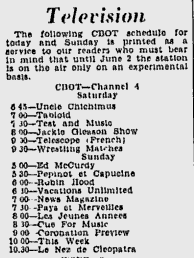 First programme listing for CBOT, The Ottawa Evening Citizen, 30 May 1953.Canadian television officially arrived in Ottawa at 2pm on 2 June 1953 when CBOT, the CBC’s third station, began regular broadcasting. Using equipment supplied by Marconi’s Wireless and Telegraph Company of Montreal, the station initially had a range of only 15 miles (24 kilometres). Its signal was later boosted to have a range of 40 miles (65 kilometres). Found on channel 4 on the television dial, CBOT actually started testing its equipment roughly two weeks earlier when a microwave relay tower built on the top of the Bell Telephone Building on O’Connor Street became operational. The microwave system, which could simultaneously carry both telephone and television signals, linked Ottawa to Toronto and Montreal. After test programmes were transmitted with “astonishing clarity” over the long May weekend, the station felt confident enough to list its programming schedule for Saturday, 30 May in the newspaper, albeit with a warning that it was still operating on an experimental basis. The station, which broadcasted for less than four hours that day, started at 6.45pm with Uncle Chichimus, the much beloved Toronto-based production starring John Conway and his two puppets, Uncle Chichimus and Hollyhock. The evening’s entertainment ended with an hour of wrestling starting at 9.30pm. During these early days of television, CBOT, like the Montreal station CBFT, offered programs in both English and French, a practice that continued until Radio Canada had its own stations. That first night’s French-language program was called Télescope.
First programme listing for CBOT, The Ottawa Evening Citizen, 30 May 1953.Canadian television officially arrived in Ottawa at 2pm on 2 June 1953 when CBOT, the CBC’s third station, began regular broadcasting. Using equipment supplied by Marconi’s Wireless and Telegraph Company of Montreal, the station initially had a range of only 15 miles (24 kilometres). Its signal was later boosted to have a range of 40 miles (65 kilometres). Found on channel 4 on the television dial, CBOT actually started testing its equipment roughly two weeks earlier when a microwave relay tower built on the top of the Bell Telephone Building on O’Connor Street became operational. The microwave system, which could simultaneously carry both telephone and television signals, linked Ottawa to Toronto and Montreal. After test programmes were transmitted with “astonishing clarity” over the long May weekend, the station felt confident enough to list its programming schedule for Saturday, 30 May in the newspaper, albeit with a warning that it was still operating on an experimental basis. The station, which broadcasted for less than four hours that day, started at 6.45pm with Uncle Chichimus, the much beloved Toronto-based production starring John Conway and his two puppets, Uncle Chichimus and Hollyhock. The evening’s entertainment ended with an hour of wrestling starting at 9.30pm. During these early days of television, CBOT, like the Montreal station CBFT, offered programs in both English and French, a practice that continued until Radio Canada had its own stations. That first night’s French-language program was called Télescope.
 Ottawa Evening Citizen 28 May 1953.The official launch of CBOT on 2 June 1953 was timed to coincide with an event guaranteed to attract the largest audience possible—the Coronation of Queen Elizabeth II. Not only were celebratory events on Parliament Hill in Ottawa televised on the three CBC stations, but the entire Coronation ceremony from London with a delay of only four hours. In “Operation Pony Express,” three RAF Canberra bombers flew film footage across the Atlantic from North Weald Airport outside of London to Goose Bay, Newfoundland, with the first plane carrying the first two hours of film coverage, with the other two planes following with later hours of coverage. In Goose Bay, the film canisters were transferred onto RCAF CF-100 fighters for the flight to the St Hubert Airport outside of Montreal. A truck then took the film to the Radio Canada building in downtown Montreal for broadcasting, with simultaneous viewing in Montreal, Toronto, and Ottawa. Coverage of the Coronation from London started at 4.30pm, after a broadcast of the ceremonies on Parliament Hill, and the Queen’s Coronation message. Prior to the start of its Coronation coverage, CBC broadcasted a test pattern and music. Regular updates on the status of the Canberra flights were also provided. The Coronation broadcast was in black and white; colour programming would not be launched in Canada until 1966, thirteen years after colour was introduced in the United States. If people wanted to see the Coronation in colour, they had to go to the cinema when the film became available a few days later.
Ottawa Evening Citizen 28 May 1953.The official launch of CBOT on 2 June 1953 was timed to coincide with an event guaranteed to attract the largest audience possible—the Coronation of Queen Elizabeth II. Not only were celebratory events on Parliament Hill in Ottawa televised on the three CBC stations, but the entire Coronation ceremony from London with a delay of only four hours. In “Operation Pony Express,” three RAF Canberra bombers flew film footage across the Atlantic from North Weald Airport outside of London to Goose Bay, Newfoundland, with the first plane carrying the first two hours of film coverage, with the other two planes following with later hours of coverage. In Goose Bay, the film canisters were transferred onto RCAF CF-100 fighters for the flight to the St Hubert Airport outside of Montreal. A truck then took the film to the Radio Canada building in downtown Montreal for broadcasting, with simultaneous viewing in Montreal, Toronto, and Ottawa. Coverage of the Coronation from London started at 4.30pm, after a broadcast of the ceremonies on Parliament Hill, and the Queen’s Coronation message. Prior to the start of its Coronation coverage, CBC broadcasted a test pattern and music. Regular updates on the status of the Canberra flights were also provided. The Coronation broadcast was in black and white; colour programming would not be launched in Canada until 1966, thirteen years after colour was introduced in the United States. If people wanted to see the Coronation in colour, they had to go to the cinema when the film became available a few days later.
With the day declared a national holiday, people scrambled to find a television to watch the historic event. In Ottawa, the Radio and Television Manufacturers Association of Canada installed televisions in every school without charge to allow all students to watch the Coronation. An abridged French-language version was also televised. Naturally, parents were invited to watch as well–a good marketing ploy. Stores also offered special Coronation deals so that families could watch the events on their own sets. One enterprising store invited those uncertain about television, or were unable to afford a receiver (the price for the monochrome receiver started at $249.99, equivalent to $2,200 today), to come in and watch the Coronation on its sets for free.
From that day on, there was no looking back. Television quickly became, as RCA had predicted in 1939, an indispensable part of every Canadian household. In 1948, there were only 325 TV sets in Canada. In 1951, roughly one percent of Canadian households, mostly located in southern Ontario in range of American TV signals, had purchased a TV set. Ten years later, 83 per cent of Canadian households had a television, a higher percentage than that of homes with indoor plumbing.
Sources:
Canadian Communications Foundation, 2013. Television Station History, Ontario, Eastern Canada, CBOT-DT (CBC Nework), Ottawa, http://www.broadcasting-history.ca.
CBC-Radio Canada, 2015. Our History, http://www.cbc.radio-canada.ca/en/explore/our-history/.
CBC, 2015, “A TV Renaissance, TV In Canada, A History,” Doc Zone with Ann-Marie MacDonald, http://www.cbc.ca/doczone/features/tv-in-canada-a-history.
Freemeth, Howard, 2010, “Television,” Historica Canada, http://www.thecanadianencyclopedia.ca/en/article/television/.
Hammond Museum of Radio, 2004, “Some Dates From Canadian Broadcasting,” http://www.hammondmuseumofradio.org/dates.html.
TV History, 2013. Television History—The First 75 Years, Television Facts and Statistics—1939 to 2000, http://www.tvhistory.tv/facts-stats.htm.
The Evening Citizen, 1951. “Ottawans Get Good Video Reception,” 11 September.
————————, 1953. “Fly TV ‘Take’ To CBC: See Coronation Same Day Here,” 6 May.
————————, 1953. “Ottawa Microwave Radio Relay Tower In Operation on May 14th,” 6 May.
————————, 1953. “TV Sets To Be Installed In Schools For June 2,” 26 May.
————————, 1953. “Station CBOT Now On The Air Each Night,” 26 May.
————————, 1953. “Television,” 30 May 1953. The Globe and Mail, 1937. “Television Is London’s Newest Christmas Gift Idea,” 13 December.
————————, 1938. “10,000 Sets Made And Sold In United Kingdom,” 13 January.
————————, 1941. “Commercial Television Is Delayed By Defense,” 3 July.
————————, 1947. Television—Canada Not Ready, Says Frigon,” 28 June.
————————, 1949. “Ottawa Studies Loan in Millions for CBC Video,” 2 March.
————————, 1949. “Claims TV Delay Due To Ottawa Pre-Election Fears,” 3 May.
————————, 1951, “Hints Windsor, Ottawa, Quebec Next In Line For Canadian Television,” 16 November.
———————-, 1953. “Temporary Television Hookup To Let Ottawa See Coronation,” 13 March.
———————-, 1953. “Jets Bring Coronation Films For TV Viewers on Tuesday,” 30 May.
———————-, 2014. “Ferris-Wheel highs and nauseating lows from 135 years of the Ex,” 13 August.
Story written by James Powell, the author of the blog Today in Ottawa's History.
Retired from the Bank of Canada, James is the author or co-author of three books dealing with some aspect of Canadian history. These comprise: A History of the Canadian Dollar, 2005, Bank of Canada, The Bank of Canada of James Elliott Coyne: Challenges, Confrontation and Change,” 2009, Queen’s University Press, and with Jill Moxley, Faking It! A History of Counterfeiting in Canada, 2013, General Store Publishing House, Renfrew, Ontario. James is a Director of The Historical Society of Ottawa.
HSO Community Project Chosen
The Society’s Board of Directors is delighted to announce that it has approved a pledge of $5,000 towards a project to construct a replica gazebo at Strathcona Park. This project was proposed by HSO member, François Bregha.
At last year’s Annual General Meeting, members agreed to allocate funds to finance community projects over the coming years. Members were asked to suggest potential projects, and a process was established to choose among projects. The selection process was based on a number of criteria, including relevance to HSO’s mission and objectives, cost, and the availability of people to take the lead on the project.
The construction of a replica pavilion at Strathcona Park has long been the dream of Action Sandy Hill, a local community group. Strathcona Park, which is located on the western bank of the Rideau River, was originally the home of the Dominion Rifle Range. During the early 20th century, the range was turned into a park by the Ottawa Improvement Commission, the forerunner of the National Capital Commission. The park is now maintained by the City of Ottawa.
The park was named in honour of Scottish-Canadian businessman, financier and politician Donald Smith who became 1st Baron Strathcona and Mount Royal in 1900. During the nineteenth century, Smith was president of the Bank of Montreal, and co-founded the Canadian Pacific Railway with his cousin George Stephen, later known as Lord Mount Stephen. Smith also for a time represented Montreal in the House of Commons. Later, he became Canada’s High Commissioner to London. Lord Strathcona was also a great philanthropist, endowing hospitals, including the Royal Victoria Hospital in Montreal. He was also Chancellor of McGill University and the University of Aberdeen.
A feature of Strathcona Park is a large fountain sculpture by Mathurin Moreau which was donated by Lord Strathcona in 1909. The four standing figures supporting a bowl represent Europe, Asia, Africa and America. Another original feature of the park was a Victorian-style gazebo, the site of many band performances and other events. Unfortunately, the aging gazebo was dismantled in 1961 and never replaced. The initiative of Action Sandy Hill to re-build the gazebo will restore a historic structure and provide a new focal point for the Park.
Planning for the structure is well advanced. Action Sandy Hill (ASH) will allocate up to $26,000 to this endeavour using money received from a developer earmarked for community benefits. The City of Ottawa has agreed to match the ASH funds. Heritage architect Barry Padolsky is contributing the gazebo design and specifications pro bono. Action Sandy Hill held a community consultation on the gazebo in September 2020 and is looking for estimates for its construction. It is also seeking funds from the broader Ottawa community to complete the financing.
The Historical Society of Ottawa is delighted to support this initiative to rebuild the gazebo and reintroduce a lost historical artifact in a well-used and much-loved park.
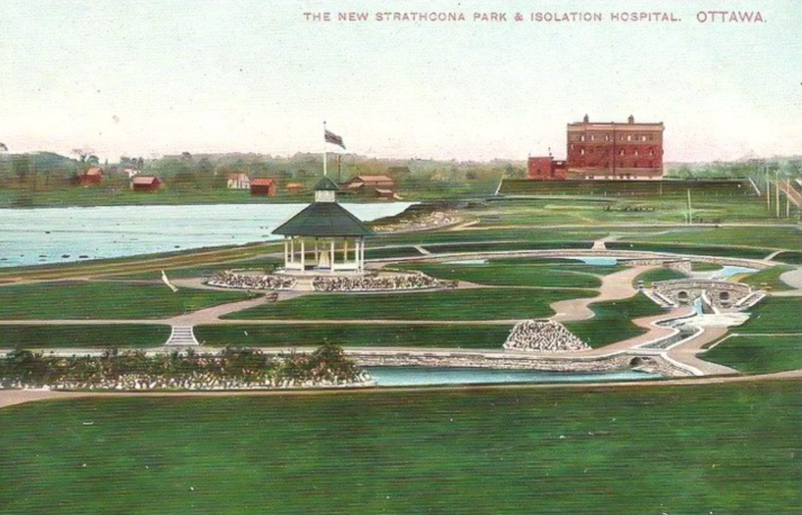
The tall building in the background is the isolation hospital, now the site of an apartment building.
The Phantom Air Raid
14 February 1915
One of the most curious events in Ottawa’s history occurred on Valentine’s Day night, Sunday 14 February 1915, six months after the start of the Great War. At roughly 10.30pm, the Prime Minister, Sir Robert Borden, received an urgent telephone call from Mayor Donaldson of Brockville informing him that at least three German airplanes had crossed the St Lawrence River from Morristown, New York. The invaders, apparently seen by scores of Brockville citizens who were returning from Sunday evening church services, had just passed directly over the community travelling in a northerly direction, presumably towards the capital. One of the planes shone a powerful searchlight on the town, lighting up its main street. Reportedly, the planes dropped “fireballs,” or “light balls,” into the river on the Canadian side of the border. Many Brockville citizens become hysterical.
After receiving the mayor’s call, Borden immediately contacted the Canadian Militia. Meanwhile, Brockville’s chief of police telephoned Colonel Percy Sherwood, Commissioner of the Dominion police regarding the air invaders. At 11.15pm, Sherwood ordered Parliament Hill to be blacked out to avoid giving the raiders an easy target. While the phlegmatic Commissioner was not unduly apprehensive about the report of approaching enemy planes, he believed it expedient to take precautionary measures, including blacking-out key government buildings. The lights that illuminated the Centre block’s Victoria Tower when Parliament was in session were extinguished. The Royal Mint, which was also typically lit up at night, was similarly darkened. At Rideau Hall, home of the Governor General, the blinds were drawn. Although the Governor General was away inspecting troops in Winnipeg, his wife, the Duchess of Connaught, was in residence. Other buildings observed the black-out as news of the pending attack hit the streets. The Globe newspaper reported that the entire city of Ottawa was in darkness that night.
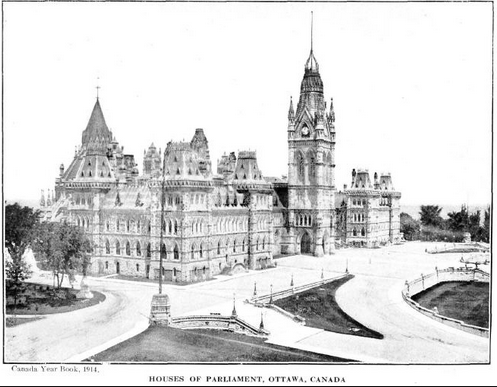 Centre Block, Houses of Parliament, Ottawa, 1914.Despite Ottawa being only 100 kilometres distant from Brockville as the crow flies, aviation experts told the Canadian authorities that it might take until midnight for the invaders to make their way to the capital owing to poor weather conditions, which included low clouds and rain. Recall that planes at that time were lucky to go much more than 100 kilometres per hour under favourable conditions. Smith Falls, Perth, and Kempville, which were on the expected flight path, were alerted, and told to keep a sharp look-out. But midnight came and went without any sign of the intruders.
Centre Block, Houses of Parliament, Ottawa, 1914.Despite Ottawa being only 100 kilometres distant from Brockville as the crow flies, aviation experts told the Canadian authorities that it might take until midnight for the invaders to make their way to the capital owing to poor weather conditions, which included low clouds and rain. Recall that planes at that time were lucky to go much more than 100 kilometres per hour under favourable conditions. Smith Falls, Perth, and Kempville, which were on the expected flight path, were alerted, and told to keep a sharp look-out. But midnight came and went without any sign of the intruders.
The next day, newspapers were full of stories on the putative air raid. The Globe’s headline screamed: “Ottawa In Darkness Awaits Aeroplane Raid. Several Aeroplanes Make A Raid Into The Dominion Of Canada.” In the streets of the capital, citizens experienced a frisson of excitement with the war apparently being brought to the city. The Ottawa Journal reported that “Ottawa feels first thrill of war,” and marvelled that usually reserved Ottawa citizens were stopping complete strangers on the street seeking news of the invaders. In the House of Commons, Sir Wilfrid Laurier rose and asked the Prime Minister for any information that he might be able to provide. Borden confirmed that he had received a telephone call from the Mayor of Brockville, and that he had communicated the news of the expected raid to the chief of the general staff, but he was “unable to give the point of departure of the aeroplanes in question.” That night, fearing that the previous night’s attack might have been aborted owing to bad weather and subsequently re-launched, government buildings were blacked out for a second night. Parliament sat as usual, but behind drawn curtains.
For two hours, Ottawa’s city council debated a motion submitted by St George Ward alderman Cunningham “that in view of the possibility of an air raid on the city hall while this august body is in session, Constable McMullen be instructed to pull down the blinds.” The Ottawa Journal wryly noted that the debate occurred under the glare of 61 electric lights which lit up the building. It also noted that the alderman frequently absented himself from the debate to climb the city hall tower to scan the skies for sight of the approaching planes so that he could be the first to warn his colleagues to take shelter in the cellar.
When no planes appeared, people started to look for other explanations. Quickly, suspicion focused on some Morristown youths, described as “village cut-ups,” who admitted to having sent up three “fireworks balloons” from the American side of the St Lawrence at about 9pm which exploded in the air above Brockville. Giving credence to this story, the remains of balloons with firework attachments were subsequently recovered from the ice on the St Lawrence two miles east of the town, as well as from the grounds of the Brockville Asylum, now called the Brockville Mental Health Centre. The ostensible reason for sending up the balloons was to commemorate the centenary of the end of the war of 1812. More likely it was a prank aimed at scaring Canadians.
Officials in Ottawa didn’t readily believe these reports. The Dominion Observatory reported that the wind that night was consistently coming from the east. It contended that as Morristown is directly opposite Brockville, any balloons sent up from the Morristown area would have travelled to the west, and certainly not in the direction the airplanes were said to have taken. The press also reported that militia authorities were in contact with Washington, and that a thorough inquiry had been set in motion to locate the airplanes’ base of operation.
Across the Atlantic in England, which had experienced its first German Zeppelin air raid just three weeks earlier, the phantom air raid on Ottawa was a source of merriment. By chance, the night after the Ottawa scare, the lights of Parliament at Westminster suddenly went out. Making a reference to the Ottawa raiders, William Crooks, Labour MP for Woolwich cheekily called out in the darkness” “Hello, they’re here!” The House of Commons cracked up with laughter.
So what really happened that Valentine’s Day night? How plausible was an attack on Ottawa?
It wouldn’t have been the first time that armed raiders had crossed the U.S. border into Canada. There were precedents. Less than fifty years earlier, the Fenians, an Irish extremist group, made a number of military forays into Canada across the U.S. border. The Ottawa Journal also claimed that German sympathizers in the United States had contemplated action against Canada during the early days of the war in 1914, going so far as to set up training bases in the United States with the objective of “making a descent upon Canada to destroy canals and railways” before being told to desist by U.S. authorities. Less than two weeks prior to the supposed air raid on Ottawa, Werner Horn, a German army reserve lieutenant, tried to blow up the Vanceboro international bridge between St Croix, New Brunswick and Vanceboro, Maine in an attempt to disrupt troop movements.
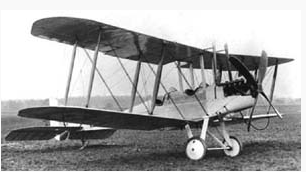 British B.E.2c, manufactured by the British Air Factor, Vickers, Bristol, circa. 1914.However, an air raid on Ottawa by German sympathizers seems highly unlikely. While on a sharp upward development trajectory, aviation was still primitive in early 1915, the first powered flight having taken place only eleven years earlier. Even at the front in France, airplanes were then mostly used for reconnaissance. Typical of that era, the British military airplane, the B.E.2c, could stay aloft for only three hours.
British B.E.2c, manufactured by the British Air Factor, Vickers, Bristol, circa. 1914.However, an air raid on Ottawa by German sympathizers seems highly unlikely. While on a sharp upward development trajectory, aviation was still primitive in early 1915, the first powered flight having taken place only eleven years earlier. Even at the front in France, airplanes were then mostly used for reconnaissance. Typical of that era, the British military airplane, the B.E.2c, could stay aloft for only three hours.
The most likely explanation is the toy balloon story, combined with a bad case of war jitters. As suggested by one of the newspapers, the searchlight beam that reportedly lit up Brockville could be explained by a fortuitous flash of lightning while the balloons were above the city. However, the fact that the Dominion Observatory was adamant in its view on the wind direction that night fuelled fears that the bombers were real.
Certain modern-day investigators have a whole different explanation—UFOs. The story of Ottawa’s phantom air raid has featured in a number of books on the paranormal, including The Canadian UFO Report: The Best Cases Revealed. To add grist to the paranormal mills, the same night Ottawa prepared for an air raid, strange lights and planes were apparently spotted over other Ontario towns.
Sources:
Colombo, John Robert, 1999. Mysteries of Ontario, Hounslow Press.
House of Commons, 1915. “Reported Appearance of Aeroplanes,” Twelfth Parliament, Fifth Session, Volume One, 15 February.
Rutkowski, Chris & Dittman, Geoff, 2006. The Canadian UFO Report: The Best Cases Revealed, University of Toronto Press, Toronto.
The Globe, 1915. “Ottawa In Darkness Awaits Aeroplane Raid,” 15 February.
————————, 1915. “Were Toy balloons and not Aeroplanes!” 15 February.
The Ottawa Journal, 1915. “House To Be Dark Again To-night,” 15 February.
————————, 1915. “Wind From East; Fact That Casts Doubt On Toy Balloon Story; But It Seems Most Likely Explanation,” 15 February.
———————-, 1915. “The Air Raid That Didn’t,” 15 February.
———————–, 1915, “Brockville Statement,” 15 February.
———————–, 1915. “Laughing at Ottawa,” 16 February.
Unikoshi, Ari, 2009. The War in the Air, http://www.firstworldwar.com/airwar/summary.htm.
This email address is being protected from spambots. You need JavaScript enabled to view it.. 2007. “The Phantom Invasion of 1915,” Rootsweb, Quebec-Research Archives, http://archiver.rootsweb.ancestry.com/th/read/QUEBEC-RESEARCH/2007-04/1176680122.
Images:
Statistics Canada. Parliament, 1914. http://www65.statcan.gc.ca/acyb07/acyb07_2014-eng.htm.
British B.E.2c, circa 1914, http://en.wikipedia.org/wiki/Royal_Aircraft_Factory_B.E.2.
Story written by James Powell, the author of the blog Today in Ottawa's History.
Retired from the Bank of Canada, James is the author or co-author of three books dealing with some aspect of Canadian history. These comprise: A History of the Canadian Dollar, 2005, Bank of Canada, The Bank of Canada of James Elliott Coyne: Challenges, Confrontation and Change,” 2009, Queen’s University Press, and with Jill Moxley, Faking It! A History of Counterfeiting in Canada, 2013, General Store Publishing House, Renfrew, Ontario. James is a Director of The Historical Society of Ottawa.
Josephine Baker
26 August 1955
If you wanted great entertainment, especially jazz, in Ottawa during in the 1950s, you went to the Quebec side of the Ottawa River. Among the many nightclubs located there, the most prominent were probably the Standish Hall Hotel in Hull and the Gatineau Country Club in Aylmer. At these locales, one saw such legendary figures as Duke Ellington, Louis Armstrong, and Sarah Vaughn. On 26 August 1955, the curtain went up at the Gatineau Country Club on the incomparable Josephine Baker, known in her adopted France as simply “La Baker.” She was in Ottawa for a week’s engagement, her first and only visit to the nation’s capital.
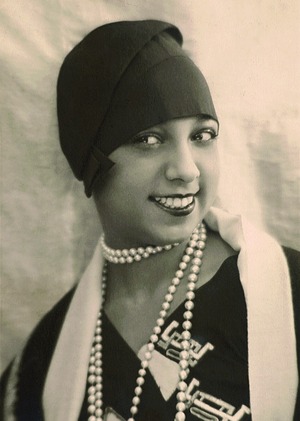 Joséphine Baker photographiée par Paul Nadar, 1930.Josephine Baker was born Freda Josephine McDonald in 1906 in St. Louis, Missouri, the daughter of a washerwoman and a vaudeville drummer who quickly abandoned his young family. A poor black girl growing up in the United States at its segregationist worst faced bleak prospects. As a young child she was cleaning houses for rich white people. By age thirteen she was waiting tables, and by age fifteen was already twice married and twice divorced. The only thing she got out of the second marriage, which lasted but a month, was her surname “Baker” which she kept throughout her life despite two more marriages…and two more divorces.
Joséphine Baker photographiée par Paul Nadar, 1930.Josephine Baker was born Freda Josephine McDonald in 1906 in St. Louis, Missouri, the daughter of a washerwoman and a vaudeville drummer who quickly abandoned his young family. A poor black girl growing up in the United States at its segregationist worst faced bleak prospects. As a young child she was cleaning houses for rich white people. By age thirteen she was waiting tables, and by age fifteen was already twice married and twice divorced. The only thing she got out of the second marriage, which lasted but a month, was her surname “Baker” which she kept throughout her life despite two more marriages…and two more divorces.
Despite this unprepossessing start in life, young Josephine Baker found her calling as an entertainer. In 1919, she joined a black vaudeville company. Two years later she came to New York, then in the midst of the Harlem Renaissance, to play in The Dixie Steppers. While initially judged too black to be in the chorus, she got her chance when a chorus girl got sick. She played the comic role of the inept dancer at the end of the chorus line who initially bungles the routine only to blossom into the troupe’s finest dancer.
Seizing an opportunity to dance in Paris, she voyaged to France in 1925 to join La Revue Nègre. Paris was a revelation. Here, a black woman could stay at the finest hotels and dine in the best restaurants without discrimination. Instead of being considered a second-class citizen or worse, she was admired and welcomed.
After touring Europe with La Revue Nègre, she joined the famous Folies Bergère. She was a huge success, her famed cemented by a dance in which she wore only a skirt made of sixteen, strategically placed bananas. Jaded French audiences had never seen such a performance. Its raw sensuality stunned them. By 1927, at the age of only twenty-one, she was the highest paid female entertainer in the world.
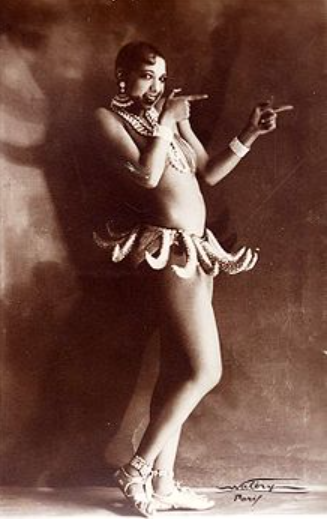 Josephine Baker, 1927, Folies Bergère, Un Vent de Folie, Waléry, Paris.She became a film star, appearing in Zouzou (1934) and Princess Tam-Tam (1935), as well as several other films. Princess Tam-Tam was banned in the United States. It was not clear what shocked white America more, showing a black woman in a relationship with a white man, or a black woman cast in the lead role. She became an inspiration to oppressed African Americans.
Josephine Baker, 1927, Folies Bergère, Un Vent de Folie, Waléry, Paris.She became a film star, appearing in Zouzou (1934) and Princess Tam-Tam (1935), as well as several other films. Princess Tam-Tam was banned in the United States. It was not clear what shocked white America more, showing a black woman in a relationship with a white man, or a black woman cast in the lead role. She became an inspiration to oppressed African Americans.
By the mid-1930s, her performance style began to change. Out went the primitive, catlike eroticism of her youth in favour of the mature, French chanteuse in the style of Edith Piaf. Parisian audiences adored her.
In 1935, Baker returned briefly to the United States to perform in New York in the famous Ziegfeld Follies. It was not a happy experience. Now a star, she was allowed to stay in one of New York’s big hotels, but only if she used the service entrance. Her performance, which included dancing with white men, was still beyond the pale of even a liberal New York audience. After newspapers insulted her and made racial comments, she returned disheartened to Paris.
In 1937, she married a wealthy Frenchman, Jean Lion. While the marriage didn’t last, she became a naturalized French citizen, renouncing her American citizenship. She famously said that the Eiffel Tower “looked very different from the Statue of Liberty, but what does that matter? What was the good of having a statue without the liberty?”
When war came, Baker took on a new role as spy and resistance fighter. Using her fame as a shield, she smuggled secret messages amongst her sheet music to the Free French. Later, after fleeing to North Africa, she performed for Allied soldiers. She insisted that she would only perform in front of integrated audiences. After the war, the French government awarded Baker the Resistance Medal with Rosette and made her a Chevalier d’honneur.
She also took on a new persona, that of a grande dame. Once famed for dancing in skimpy costumes, she now showcased the finest in French fashion, wearing designer gowns from Christian Dior and other leading fashion houses. In 1947, she married Jo Bouillon, a French orchestra leader.
She tried another return to the United States in 1951. She again insisted that she would only perform in front of non-segregated audiences. Her U.S. tour, which began in Miami, was a great success until she was denied service at New York’s prestigious Stork Club. After making an official complaint to the Club, she got into a battle of words with the famed American journalist Walter Winchell who accused her of being a communist. This was at the height of Senator McCarthy’s anti-communist crusade that led to hundreds of American entertainers being blacklisted. Baker was banned from the United States for nine years.
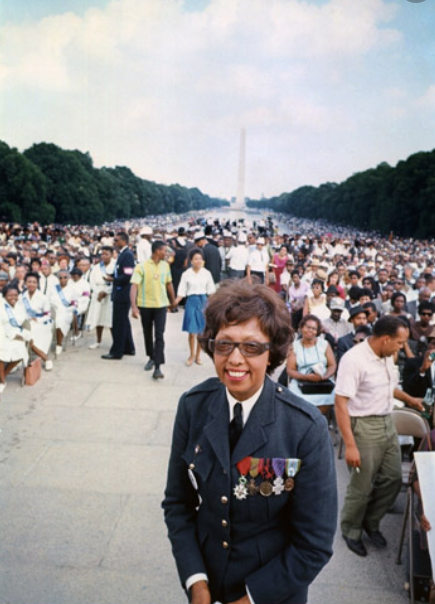 Josephine Baker, March on Washington, 1963, Château des Milandes.Through the 1950s, Baker and Jo Boullion raised a group of dozen adopted children of all races which they called The Rainbow Tribe at Baker’s chateau, Les Milandes, and 700-acre estate in the Dordogne region of France. It was Baker’s effort to demonstrate that people of all nationalities could live together in peace and harmony.
Josephine Baker, March on Washington, 1963, Château des Milandes.Through the 1950s, Baker and Jo Boullion raised a group of dozen adopted children of all races which they called The Rainbow Tribe at Baker’s chateau, Les Milandes, and 700-acre estate in the Dordogne region of France. It was Baker’s effort to demonstrate that people of all nationalities could live together in peace and harmony.
Maintaining a fifteenth-century chateau while raising such a large family became even more onerous when Baker’s fourth marriage failed. Never a good business person, and very generous, Baker ran up large debts. Eventually, she lost her chateau to creditors, and had to return to the stage to repay her debts. Helped by Princess Grace of Monaco, she and her Rainbow Tribe took up residence in a home in Monaco.
In 1963, Baker was invited to join the March on Washington with Martin Luther King Jr. and other civil rights leaders. Wearing her French military uniform with all of her medals, she appeared on the podium where she gave a short speech of support. She said that it was “the happiest day of her life.”
That summer of 1955, when Josephine Baker came to Ottawa, the great entertainer stayed at the Château Laurier Hotel while she performed at the Gatineau Country Club. Travelling with her were her French maid, Miss Jeanette Renaudin, her musical director, Mikos Bartek, nine trucks of clothes, and a photograph of her husband, Jo Bouillon. Press reports said that her wardrobe was insured for $250,000 ($2.5 million in today’s money).
She started her visit with a press conference and special performance at the Press Club in Ottawa a few days before the official start of her gig. Dressed in a slinky black dress, she wowed the journalists in the room who wondered whether she would have a wardrobe malfunction. “If accidents happen, well, c’est la mode,” she said. Bob Blackburn, the Citizen reporter, said there was no describing her, “even the most extravagant adjectives can’t do her justice.”
Talking about her decision to go to Paris back in 1925, Baker told that journalists that she had been looking for more freedom to express herself. In the United States, the only thing a black woman could do in show business was to wear a bandana on her head. She hoped that her example would open doors in other fields for other African Americans.
She also claimed to have been one of the first entertainers to appear before a television camera. The event occurred in 1935 in the BBC Studios in England. She said that she was put in a little cubicle with her face painted white since that was the only way she could be seen on the equipment of that time. “Image me with a white face!” she exclaimed.
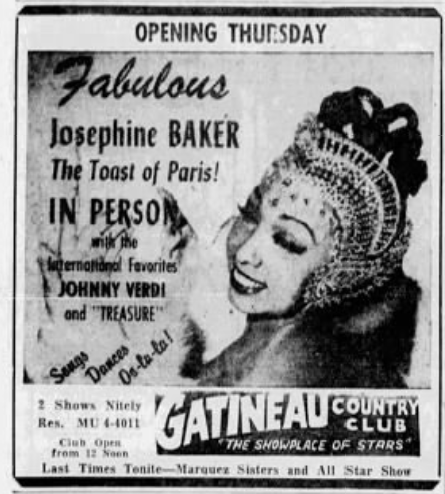 Advertisement, Ottawa Citizen, 24 August 1955.At the Press Club, she sang in both French and English, performing her old favourites such as J’attendrai. There was a lot of focus on her wardrobe for her performance which ranged from a simple white tailored blouse to extravagant evening gowns. One gown, “a sheath-like creation” was decorated in an oyster shell pattern. As she walked, the shells opened to reveal smaller shells and little pearls.
Advertisement, Ottawa Citizen, 24 August 1955.At the Press Club, she sang in both French and English, performing her old favourites such as J’attendrai. There was a lot of focus on her wardrobe for her performance which ranged from a simple white tailored blouse to extravagant evening gowns. One gown, “a sheath-like creation” was decorated in an oyster shell pattern. As she walked, the shells opened to reveal smaller shells and little pearls.
Other engagements in Ottawa included a visit to the French Embassy and radio interviews in both languages.
On opening night in the Carnival Room at the Gatineau Country Club, Josephine Baker received a standing ovation. She wowed the audience with her showmanship, her informal bantering with the audience, and her ability to sing straight from the heart. Among the many songs she sung were Unchained Melody and Begin the Beguine. She modelled gowns by Christian Dior, Jean Dessès, and others. The Ottawa Citizen reported “Here is an entertainer who deserves all the superlatives one can name. She will live in your memory for many years to come. This is Josephine Baker, the incomparable.”
Josephine Baker, entertainer sans pareil, World War II hero and civil rights leader, died in April 1975 at the age of 68, struck down by a cerebral hemorrhage, one day after opening a new show at the Bobino Theatre in Paris celebrating fifty years in show business. A week later, 20,000 people attended her funeral at La Madaleine in Paris. The French government gave her a twenty-one-gun salute. She was buried with full military honours in le Cimetière de Monaco in Monaco.
An inspiration to many, including Beyoncé, today’s megastar, Josephine Baker once said “Surely the day will come when colour means nothing more than the skin tone, when religion is seen uniquely as a way to speak one’s soul, when birth places have the weight of the throw of the dice and all men are born free, when understanding breeds love and brotherhood.”
We have a long way to go.
Sources:
BBC Wales, 2006. Josephine Baker: The First Black Superstar, https://www.youtube.com/watch?v=Ggb_wGTvZoU. YouTube.
Caranvates, Peggy, 2015. The Many Face of Josephine Baker: Dancer, Singer, Activist, Spy, Chicago Review Press, Chicago, Illinois.
Château et jardins des Milandes, Demure de Josephine Baker, 2020. Josephine Baker, Tribute to a Great Lady, https://www.milandes.com/en/josephine-baker/.
Official Site of Josephine Baker, 2020. https://www.cmgww.com/stars/baker/.
Ottawa Citizen, 1955. “They Call Her Fabulous But That Is Inadequate,” 24 August.
——————, 1955. “Josephine Baker Has Gala Wardrobe,” 25 August.
——————, 1955. “Standing Ovation For Baker At Gatineau,” 27 August.
Ottawa Journal, 1955. “Toast Of Paris, Josephine Baker Entertains Press,” 24 August.
——————-, 1975. “Singer, 68, dies in Paris,” 12 April.
——————-, 1955. “Final Tribute for Josephine,” 16 April.
Story written by James Powell, the author of the blog Today in Ottawa's History.
Retired from the Bank of Canada, James is the author or co-author of three books dealing with some aspect of Canadian history. These comprise: A History of the Canadian Dollar, 2005, Bank of Canada, The Bank of Canada of James Elliott Coyne: Challenges, Confrontation and Change,” 2009, Queen’s University Press, and with Jill Moxley, Faking It! A History of Counterfeiting in Canada, 2013, General Store Publishing House, Renfrew, Ontario. James is a Director of The Historical Society of Ottawa.
Meet Me at Murphy's
29 January 1983
One of the greatest of the shopping emporiums that used to line Sparks Street, once the commercial heart of Ottawa, was Murphy-Gamble’s. It ranked amongst the finest Canadian department stores, and had a well-earned reputation for quality merchandise. The store attracted the custom of the city’s elite, including governors general and prime ministers. But its particular claim to fame was its restaurant, the Rideau Room, located on the fifth floor of the building at 118-124 Sparks Street. It was the only Ottawa’s department store that featured a dining room. Here, one could enjoy fine food accompanied by a live band, sometimes a trio, sometimes a seven-piece orchestra. It also served high tea each afternoon to weary customers who needed to catch their breath before renewing their assault on the store’s many departments. “Meet Me At Murphy’s” became an oft-heard refrain.
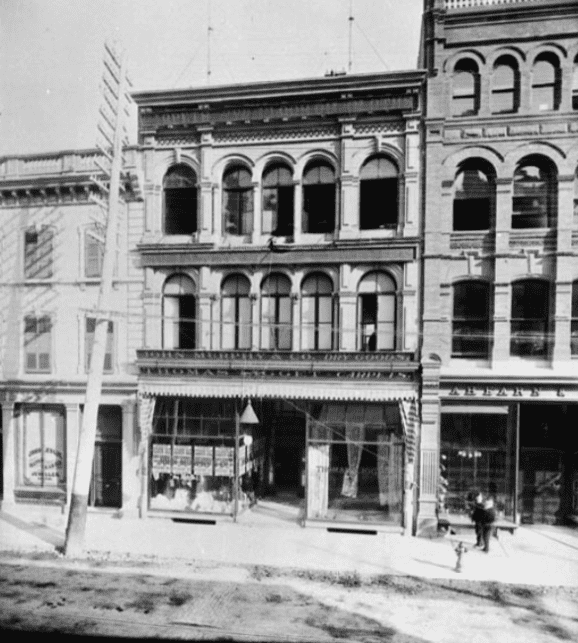 John Murphy Company, 66-68 Sparks Street, August 1892, Topley Studios, Library and Archives Canada, 138219.Murphy’s roots actually begin in Montreal where in 1867, John L. Murphy opened a dry-goods store on Catherine Street. In 1890, Murphy expanded to Ottawa, buying Argyle House, a dry-goods store located at 66-68 Sparks Street from David Gardner who had himself acquire the entire stock of Argyle House for 61 cents on the dollar in a bankruptcy sale. He also leased the premises for a few months to clear the stock. Argyle House had been known for its high-end merchandise and for catering to Ottawa’s elite. The store had originally been opened in the early 1870s by James Russell.
John Murphy Company, 66-68 Sparks Street, August 1892, Topley Studios, Library and Archives Canada, 138219.Murphy’s roots actually begin in Montreal where in 1867, John L. Murphy opened a dry-goods store on Catherine Street. In 1890, Murphy expanded to Ottawa, buying Argyle House, a dry-goods store located at 66-68 Sparks Street from David Gardner who had himself acquire the entire stock of Argyle House for 61 cents on the dollar in a bankruptcy sale. He also leased the premises for a few months to clear the stock. Argyle House had been known for its high-end merchandise and for catering to Ottawa’s elite. The store had originally been opened in the early 1870s by James Russell.
The new John Murphy & Company store prospered under the management of Samuel Gamble, the company’s first vice-president who also happened to be John Murphy’s son-in-law. In 1904, John Murphy, now seventy years of age, sold his Montreal store to Robert Simpson Company of Toronto. The store continued to operate under the well-respected John Murphy & Company name. This left the Ottawa branch, now a stand-alone operation, to find a new name. In recognition of the success achieved under Samuel Gamble’s direction, the Murphy, Gamble Company was born. John Murphy continued to act as an advisor to the firm, his knowledge being invaluable. During his career as a merchant, he had made more than 100 ocean crossings to buy quality goods from European fashion houses. At this time, the three-storey building at 66 Sparks Street was expanded back towards Queen Street, thereby increasing the selling space by one-third.
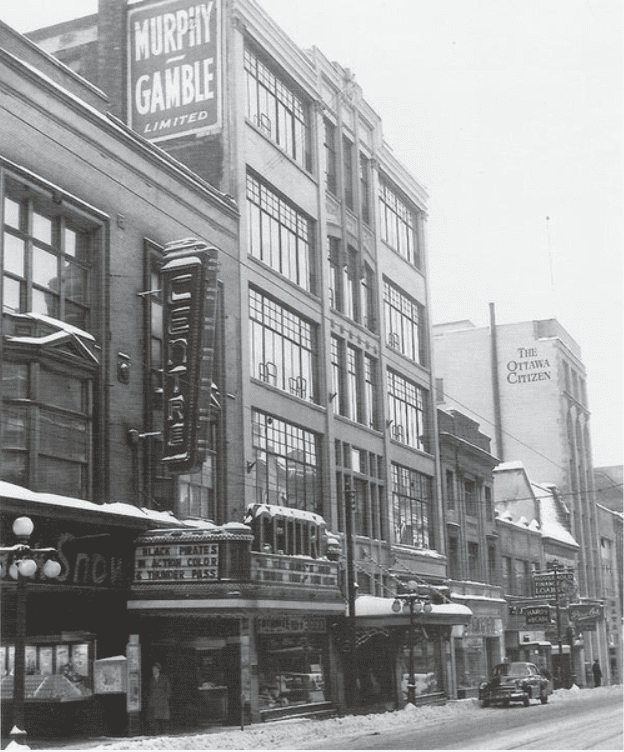 Murphy-Gamble Co at 118-124 Sparks Street, circa. 1955. The Centre Cinema next door is showing a double feature of Black Pirates and Thunder Pass which were both released in 1954. Notice the old Ottawa Citizen building on the right. Rankly.com.In 1910, the company expanded again. A five-storey store was constructed at 118-124 Sparks Street, the former site of the Brunswick Hotel. The new store opened in early January 1910. The last day of trading out of the old premises proved to be memorable. So many shoppers, mostly women, crowded into the store to snap up merchandise on sale that store staff were overwhelmed. Police had to be called in to control the enthusiastic shoppers. For an hour and a half, the doors were locked with “blue coats” on guard to repel would-be bargain hunters from storming inside. The next day, Murphy-Gamble’s new premises were also swamped by shoppers wanting to get a first glimpse at the new department store. That opening day, uniformed boys assisted ladies from their cars and carriages into and out of the emporium.
Murphy-Gamble Co at 118-124 Sparks Street, circa. 1955. The Centre Cinema next door is showing a double feature of Black Pirates and Thunder Pass which were both released in 1954. Notice the old Ottawa Citizen building on the right. Rankly.com.In 1910, the company expanded again. A five-storey store was constructed at 118-124 Sparks Street, the former site of the Brunswick Hotel. The new store opened in early January 1910. The last day of trading out of the old premises proved to be memorable. So many shoppers, mostly women, crowded into the store to snap up merchandise on sale that store staff were overwhelmed. Police had to be called in to control the enthusiastic shoppers. For an hour and a half, the doors were locked with “blue coats” on guard to repel would-be bargain hunters from storming inside. The next day, Murphy-Gamble’s new premises were also swamped by shoppers wanting to get a first glimpse at the new department store. That opening day, uniformed boys assisted ladies from their cars and carriages into and out of the emporium.
Reportedly, the new store cost $175,000 to build; no expense was spared in its construction and its fittings. As far as possible, contracts and subcontracts were awarded to local Ottawa firms. Its architect was Ottawa’s Colborne Powell Meredith, it’s builder, Frederick W. Carling. The building, apparently one of the first of its kind in eastern Ontario, was constructed of reinforced concrete, a new method at that time. It also boasted what has been described as “Chicago-style glazed curtain wall façades” on both its Sparks and Queen Street sides. The pillars holding up the five storeys were also made of concrete, reinforced with steel rods, as were the stairways. There were hardwood floors throughout. The building was deemed fire proof, and was equipped with automatic fire doors and hoses on each floor. It was the first building in the city to carry electricity and lighting through underground conduits. The new edifice was called the Carling Block, presumably in honour of its builder.
On the basement level, which opened onto Queen Street, there was a high-class grocery store. There were windows displays along the entire façade. To one side was an entrance and a passageway for receiving goods. Lockers and toilets for male employees were located on this floor, The Sparks Street entrance, which was covered by a marquee, was to be found on the first, or ground floor. All interior fittings on this floor were made of mahogany. Window displays ran along Sparks Street. Two public telephones were located here for the use of customers. The women’s and men’s clothing departments were on this floor. The millinery and mantles department were found on the second floor. Fittings on this floor were made of oak. To the rear were offices; dressing rooms were located on the sides. A spacious stairway led from the main floor to an overhead gallery, or ladies’ waiting room, called “The Mezzanine.” On the third floor was the carpet, curtains and draperies department, along with customers’ washrooms. The fourth floor was devoted to manufacturing purposes, while the fifth floor was initially used for storage and bathroom facilities for female staff. Later, the fifth floor became the site of the “Tea Rooms” and later the much-loved “Rideau Room” dining room.
Samuel Gamble died in 1913 and the management of Murphy-Gamble’s passed first to Mr. J.T. Hammill and then to Mr. S.L.T. Morrell. In 1925, James L. Murray, and his two sons, Walter L. Murray and G. Scott Murray, purchased Murph-Gamble’s. The Murrays operated a similar business in Hamilton, Ontario called Murray Sons, Ltd. The two Murray sons moved to Ottawa to manage the Ottawa firm which continued to trade under the Murphy-Gamble marque. The firm thrived under the new management. Two more floors at the back of the store and an elevator were added in 1948. The firm also established buying offices in all the major cities of Europe, as well as in Mexico and the Far East.
On staff at Murphy-Gamble’s was a master tailor and dress designer, Ernest Gordon. A Gordon gown was a much sought-after attire for gala events. Reportedly, Princess Juliana of the Netherlands bought a Gordon gown. Gordon died in 1948, having worked at Murphy’s for thirty-three years.
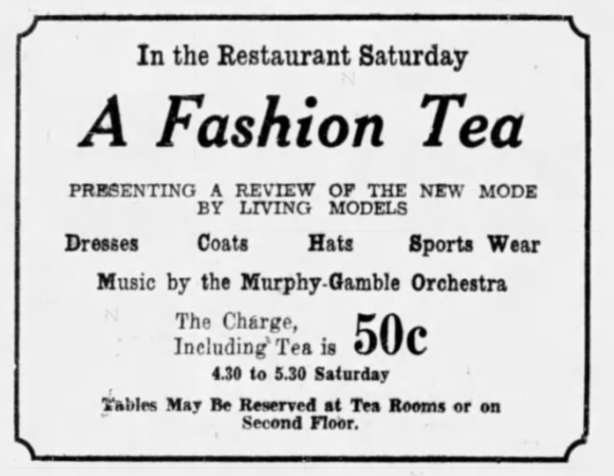 Advertisement for Tea and a Modelling Show, Ottawa Citizen, 26 September 1927.Christmas was a special time of the year at Murphy-Gamble’s. A fifty-foot Christmas tree was installed by the stairwell each year until later renovations made this impossible. A store choir sang carols every day during the week leading up to Christmas. Instead of Santa Claus coming to the store’s toy department, a series of parties was held for children in the Rideau Room where Santa gave a gift to every child. Easter was also special, bringing a visit from the Easter Bunny who handed out candy to the kiddies along with a copy of the Easter Bunny story.
Advertisement for Tea and a Modelling Show, Ottawa Citizen, 26 September 1927.Christmas was a special time of the year at Murphy-Gamble’s. A fifty-foot Christmas tree was installed by the stairwell each year until later renovations made this impossible. A store choir sang carols every day during the week leading up to Christmas. Instead of Santa Claus coming to the store’s toy department, a series of parties was held for children in the Rideau Room where Santa gave a gift to every child. Easter was also special, bringing a visit from the Easter Bunny who handed out candy to the kiddies along with a copy of the Easter Bunny story.
Murphy’s was also known for going the extra mile for its customers. Reportedly, a bride-to-be asked Murphy’s to bake her wedding cake, just as the firm had done for her mother and grandmother before her. There was one hitch. The bride lived in the North West Territories. Undeterred, Murphy’s delivered the cake via a military plane and dog sled!
Murphy-Gamble Company stayed in the Murray family for close in fifty years. In 1972, now under the presidency of Russell Boyce, the son-in-law of Scott Murray, the venerable Ottawa landmark was sold to Robert Simpson Company, the same company that purchased the original family store in Montreal in 1904. All 300 of Murphy-Gamble’s staff were re-hired. The Murphy-Gamble sign came down to be replaced by Simpson’s.
 Robert Simpson Company logo.Simpson’s operated out of the 118-124 Sparks Street location for eleven years. At the end of 1982, Simpson’s, now owned by the Hudson’s Bay Company, announced that the Sparks Street store would close owning to low profit margins. The Ottawa Citizen said that shoppers were like “mourners at an Irish wake.” On 29 January 1983, Simpson’s closed its doors for a last time with the loss of 85 permanent and 150 part-time jobs. The company published a final “Thank You” to its loyal Ottawa customers. The closure of the store after almost seventy-five years of business under various owners marked the end of a retail tradition. It left only the budget-conscious Zellers remaining as the last department store on Sparks Street until it too closed in 2013.
Robert Simpson Company logo.Simpson’s operated out of the 118-124 Sparks Street location for eleven years. At the end of 1982, Simpson’s, now owned by the Hudson’s Bay Company, announced that the Sparks Street store would close owning to low profit margins. The Ottawa Citizen said that shoppers were like “mourners at an Irish wake.” On 29 January 1983, Simpson’s closed its doors for a last time with the loss of 85 permanent and 150 part-time jobs. The company published a final “Thank You” to its loyal Ottawa customers. The closure of the store after almost seventy-five years of business under various owners marked the end of a retail tradition. It left only the budget-conscious Zellers remaining as the last department store on Sparks Street until it too closed in 2013.
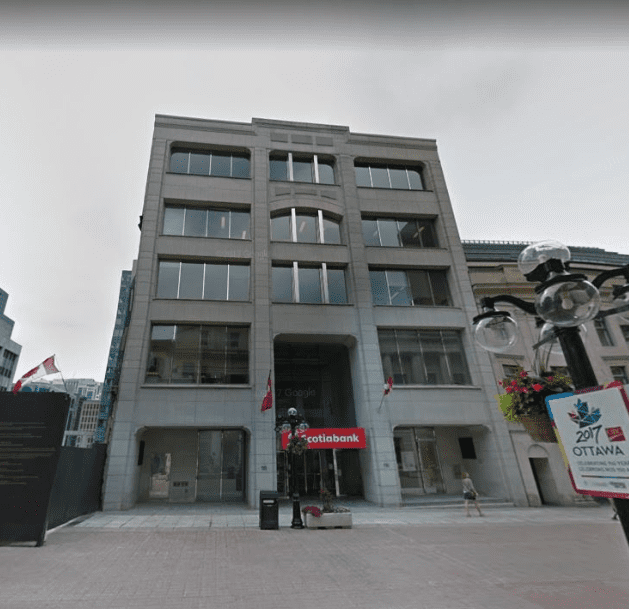 Bank of Nova Scotia, Sparks Street Branch, the former Murphy-Gamble building, 2017, Photo credit: Nelia.The former Murphy-Gamble/Simpson’s building was acquired by the Bank of Nova Scotia in January 1983. After extensive renovations, the former department store was converted into a bank branch.
Bank of Nova Scotia, Sparks Street Branch, the former Murphy-Gamble building, 2017, Photo credit: Nelia.The former Murphy-Gamble/Simpson’s building was acquired by the Bank of Nova Scotia in January 1983. After extensive renovations, the former department store was converted into a bank branch.
Sources:
Biographical Dictionary of Architects in Canada, 1800-1950, Meredith, Colborne Powell, http://www.dictionaryofarchitectsincanada.org/node/1483.
Daily Citizen, 1890. “$68,000 Bankrupt Stock of Dry Goods,” 17 May.
Heritage Ottawa, 1983. Newsletter, February.
Ottawa Citizen, 1972. “Fond farewell to Murphy’s,” 24 June.
—————-, 1982. “Simpsons’ loyal friends already mourning loss,” 31 December.
Ottawa Evening Citizen, 1910. “Last Day Was Memorable One,” 10 January.
—————————–, 1925, “Murphy-Gamble, Ltd. Store Acquired By Hamilton Firm,” 1 September.
—————————–, 1952. “Walter M. Murray Is New Head of Murphy-Gamble,” 18 November.
Evening Journal, 1890. “Argyle House,” 18 December.
Ottawa Journal, 1904. “Retail Dry Goods Deal,” 21 December.
——————-, 1910. “Magnificent New Addition To Ottawa’s Commercial Buildings,” 26 February.
Urbsite, 2012. Murphy-Gamble, Sparks’ Department Stores III, 14 May.
Story written by James Powell, the author of the blog Today in Ottawa's History.
Retired from the Bank of Canada, James is the author or co-author of three books dealing with some aspect of Canadian history. These comprise: A History of the Canadian Dollar, 2005, Bank of Canada, The Bank of Canada of James Elliott Coyne: Challenges, Confrontation and Change,” 2009, Queen’s University Press, and with Jill Moxley, Faking It! A History of Counterfeiting in Canada, 2013, General Store Publishing House, Renfrew, Ontario. James is a Director of The Historical Society of Ottawa.
The Battle of the Hatpins
7 January 1916
The British North America Act, which established the Dominion of Canada in 1867, was an ambitious piece of legislation. In addition to uniting the Province of Canada, New Brunswick and Nova Scotia, the Act was crafted to meet the aspirations of its English and French communities as well as to guarantee the religious educational rights of Roman Catholics and Protestants.
The Act split the Province of Canada into the overwhelmingly English-speaking Ontario, and the predominantly French-speaking Quebec. Each could now exercise a wide range of powers in their respective jurisdictions without having to compromise with the other—a problem in the old Province of Canada where both, then called Canada West and Canada East, were equally represented in the legislature. With the English-speaking population growing rapidly relative to the French-speaking population, it was not politically feasible to maintain the original parity of seats in the House of Assembly between the two linguistic groups. The establishment of a separate Quebec ensured that French-speakers remained in control of their traditional territory within the Dominion.
Section 133 of the Act also guaranteed that both English and French would be used in the parliaments of Canada and Quebec as well as in federal and Quebec courts. Section 93 additionally recognized educational rights under which Roman Catholics in Ontario and Protestants in Quebec could attend their own schools distinct from the public-school systems of the two provinces.
The BNA Act was not perfect, however. Education, which was a provincial responsibility, was based on religion not language. While most francophones were Roman Catholic, not all Roman Catholics were francophone. This lack of congruence and the fact that the BNA Act did not speak to the language of instruction in delivering education were to become a flashpoint in English-French relations in Canada.
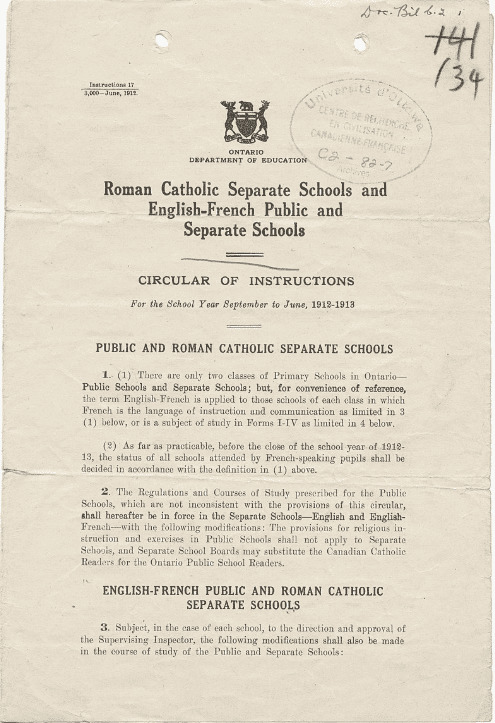 Cover page of Regulation 17 that restricted the use of French as the language of instruction in Ontario’s elementary schools, 1912, University of Ottawa.For many years after Confederation, minority French-speaking Ontarians attended separate elementary schools where French was used as the language of instruction. However, English-speaking Ontarians increasingly felt threated by the migration of French-Canadians into Ontario, especially into the eastern part of the province. By the end of the nineteenth century, the francophone population of Ontario had roughly doubled to 10 per cent. While English-speakers had to tolerate the use of French in Quebec and at the federal level given the BNA Act, they considered Ontario to be a British province in a British country. A growing French presence in Ontario was something that many could not abide.
Cover page of Regulation 17 that restricted the use of French as the language of instruction in Ontario’s elementary schools, 1912, University of Ottawa.For many years after Confederation, minority French-speaking Ontarians attended separate elementary schools where French was used as the language of instruction. However, English-speaking Ontarians increasingly felt threated by the migration of French-Canadians into Ontario, especially into the eastern part of the province. By the end of the nineteenth century, the francophone population of Ontario had roughly doubled to 10 per cent. While English-speakers had to tolerate the use of French in Quebec and at the federal level given the BNA Act, they considered Ontario to be a British province in a British country. A growing French presence in Ontario was something that many could not abide.
One way of ensuring that English remained predominant was through assimilation. In 1885, English became a compulsory subject in all elementary schools in Ontario. Five years later, English became the language of instruction in all schools except where the use of English was impracticable, i.e. when students were unable to understand English. Using this exemption, bilingual separate schools continued to teach in French.
In 1912, the Conservative Ontario government of Sir James Whitney toughened the legislation with the introduction of Regulation 17. The Regulation forbade the use of French as the language of instruction beyond grade 2 in Ontario’s separate schools. When Ottawa’s separate schools ignored the regulation, the government followed up with Regulation 18 which revoked the teaching certification of instructors who persisted in teaching in French, making them “unqualified to teach,” and rescinded financial support for school boards that defied Regulation 17. Ottawa’s bilingual separate schools continued to resist.
Fighting the French cause was the French-Canadian Education Association of Ontario (l’Association canadienne-française d’éducation d’Ontario), led by Senator Napoléon Antoine Belcourt. The Association was supported by Ottawa’s French-speaking, Roman Catholic clergy. The Ottawa newspaper Le Droit was also a powerful advocate. It was founded in 1913 for the express purpose of supporting the city’s francophone community in its struggle for its rights. Note that Ottawa’s French-Canadians repeatedly said that they strongly supported the study of English, which they viewed as necessary in a largely anglophone province. They just wanted to protect the language of their forebears and culture.
On the government’s side in support of Regulation 17 were two unlikely allies–the politically powerful Orange Order, which consisted of mainly Irish Protestants who were fiercely anti-Catholic and pro British Empire, and Irish Roman Catholics.
Relations between Irish Catholics and their French-speaking co-religionists in Ottawa had never been good. And they deteriorated further with the influx of francophones as the two Catholic communities competed for dominance. So strained were the relations that in 1915 Father Whelan of St. Patrick’s Church in Ottawa wrote an open letter to Cardinal Bégin of Quebec, under whose jurisdiction the Diocese of Ottawa fell, and to Sir Lomer Gouin, the Premier of Quebec, complaining that it was French Canadians who were stirring up racial feeling, introducing intolerance and inflaming public feeling.
One front of this Irish-French battle was Ottawa’s Separate School Board. Led by Mr. Samuel Genest, its majority francophone chairman, the board had refused to implement Regulation 17 over the objections of its minority, English-speaking, Irish-Catholic trustees. This led to the loss of the provincial education subsidy, affecting both French- and English-speaking students alike. Relations between the co-religionists nose-dived when, at the behest of the English-speaking trustees, the court issued an injunction to stop the board from paying the salaries of “unqualified” French-speaking teachers—32 Christian brothers and four nuns. In response, Genest refused to pay English-speaking teachers. As a consequence, all teachers went for months without a pay cheque.
To circumvent Genest and the francophone-dominated board, Ontario’s Department of Education paid the English teachers their salaries and arrears directly. Bilingual teachers. i.e. French teachers, were not paid. Subsequently, the Ontario government passed legislation establishing a three-man commission, consisting of two anglophones and one francophone in the summer of 1915 to replace Ottawa’s elected separate school board.
The start of the school year in September 1915 saw the government-appointed commission and the elected separate school board vying for control of the schools. Two young sisters, Béatrice and Diane Desloges, who had been appointed by the school board began teaching in French at the Guigues School at 159 Murray Street in Lowertown in defiance of both the commission and an order by the Superior Court of Ontario. Declaring the two sisters “unqualified” to teach since they would not abide by Regulation 17, the commission hired two replacement teachers, the Misses Lafond, to instruct their classes in English. When the Lafond sisters turned up at Guigues School, they found empty classrooms. Their students, with the support of their parents, had decamped to the chapel to continue their instruction by the Desloges sisters in French. Subsequently, the Desloges sisters conducted their classes in rooms at the corner of Guigues and Dalhousie Streets.
Matters came to a head when schools reopened in January 1916 after the Christmas holidays. On the first day back, fifty people, mostly women, escorted the Desloges sisters from their make-shift classrooms to the Guigues School. Entering the school with the mothers, the two young teachers took charge of roughly ninety boys and began instructing them in French. When the two Lafond sisters showed up at 9:00 am, they found their entry into the school blocked. The francophone mothers, armed with hatpins to ward off any assault by police or supporters of Regulation 17, brought in provisions and set up a makeshift kitchen in case of a lengthy siege.
The chairman of the government-appointed school commission, Mr. Denis Murphy, thundered that he intended to deal with the situation “with an iron hand,” and that “sterner measures” would be taken that coming Friday if the francophone mothers and teachers persisted in their efforts. Meanwhile, female lookouts were posted to watch out for police and supporters of Regulation 17. An Ottawa Journal reporter called them “a twentieth-century rejuvenation of the women of the French Revolution.” There was, however, no trouble. Despite rumours that police had been asked by the commission to storm the school, the police did not show up.
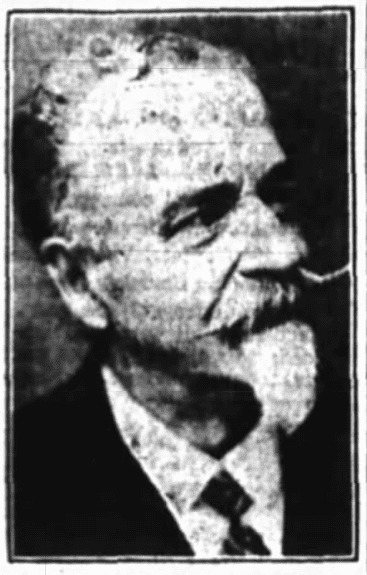 Samuel Genest, Chairman of the Separate School Board of Ottawa, Ottawa Journal, 26 April 1937.The peace was temporary. On Friday, 7 January 1916, the commission acted, sending in more than twenty-five policemen to take control of Guigues School. They managed to enter the building when the doors were opened to admit some Christian brothers who taught at the school, but later retreated in face of stout resistance from the mothers. One constable had his thumb bitten and another received a black eye. While the fracas was underway, the Desloges sisters entered the school by a side door and were carried shoulder high by the mothers to their classrooms located on the second floor of the building. On reaching her classroom, one of the sisters waved through an open window overlooking Murray Street, receiving a loud cheer from her supporters below.
Samuel Genest, Chairman of the Separate School Board of Ottawa, Ottawa Journal, 26 April 1937.The peace was temporary. On Friday, 7 January 1916, the commission acted, sending in more than twenty-five policemen to take control of Guigues School. They managed to enter the building when the doors were opened to admit some Christian brothers who taught at the school, but later retreated in face of stout resistance from the mothers. One constable had his thumb bitten and another received a black eye. While the fracas was underway, the Desloges sisters entered the school by a side door and were carried shoulder high by the mothers to their classrooms located on the second floor of the building. On reaching her classroom, one of the sisters waved through an open window overlooking Murray Street, receiving a loud cheer from her supporters below.
The mothers guarded the doors, corridors and staircases of the school, ready for another police sortie. More police arrived on the scene to take up positions around the school. The Journal commented that it would have taken “only a breath to turn the whole bilingual situation into a pitched battle and rioting.” Fortunately, calmer heads prevailed. The police withdrew, leaving the field of the “Battle of the Hatpins” in the hands of the francophone mothers.
With the Guigues School “occupied” by the women, the war shifted to the courts. In the meantime, the government-appointed school commission refused to pay the bilingual teachers. Senator Belcourt, the head of the French-Canadian Education Association, tested the constitutionality of Regulation 17 in Ontario’s Courts. Losing his case there, he took the matter to the Privy Council in London, then Canada’s highest court of appeal. In November 1916, the Privy Council ruled on two issues—the legality of the government appointing a school commission to replace the recalcitrant school board and, more fundamentally, the legality of Regulation 17. It came down with a split decision. It ruled against the commission, calling its appointment ultra vires. However, the Privy Council sustained Regulation 17.
While opponents of Regulation 17 were disappointed by the second decision, they were philosophical about it. Le Droit opined that while they had suffered a setback, it gave them a reason to close ranks and unite. The fight was not yet over. With the government-appointed commission declared illegal, the old school board headed by Samuel Genest regained control of all separate schools in Ottawa. One of the board’s first acts, in defiance of the government and the court injunction brought against it by the English-speaking board trustees, was to pay the salaries and arrears owed to the bilingual teachers, many of who had been unpaid since September 1914.
Legal suits began to fly as the school board wrested control of funds held in local banks in the name of the now illegal and defunct school commission. It also sued members of the commission. Concurrently, the minority English-speaking board trustees continued their campaign against paying the bilingual teachers who refused to comply with Regulation 17. Samuel Genest, who appeared in multiple court hearings, was threatened with jail for contempt of court owing to his refusal to turn over evidence showing that the separate school board had paid “unqualified” teachers. When he finally did, the suggestion of jail was quietly dropped even though the pay stubs clearly showed that the board had paid the bilingual teachers in defiance of the government.
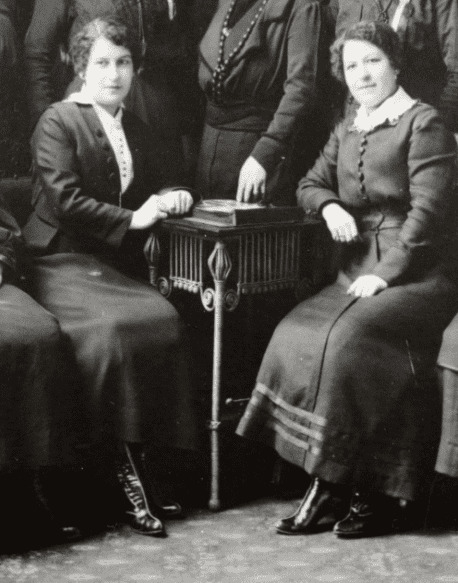 Diane and Béatrice Deloges, les gardiennes de Guigues, Author unknown, University of Ottawa.In the end, the government did not have the political appetite to pursue the issue further. French continued as the language of instruction at Guigues School despite the regulation. In 1925, with the political winds shifting, Premier Howard Ferguson, who had been the Minister of Education during the Battle of the Hatpins, appointed the Scott-Merchant-Côté Commission to look into the bilingual issue. Two years later, the government stopped enforcing Regulation 17 province-wide, and instruction in French resumed in Ontario schools. This decision, which was controversial in many Conservative circles, caused The Telegram, a Toronto-based newspaper, to claim with considerable hyperbole that English would be abolished in great areas of Ontario. Regulation 17 remained on Ontario’s statute books until 1944.
Diane and Béatrice Deloges, les gardiennes de Guigues, Author unknown, University of Ottawa.In the end, the government did not have the political appetite to pursue the issue further. French continued as the language of instruction at Guigues School despite the regulation. In 1925, with the political winds shifting, Premier Howard Ferguson, who had been the Minister of Education during the Battle of the Hatpins, appointed the Scott-Merchant-Côté Commission to look into the bilingual issue. Two years later, the government stopped enforcing Regulation 17 province-wide, and instruction in French resumed in Ontario schools. This decision, which was controversial in many Conservative circles, caused The Telegram, a Toronto-based newspaper, to claim with considerable hyperbole that English would be abolished in great areas of Ontario. Regulation 17 remained on Ontario’s statute books until 1944.
Many people were involved in this fight for French-language education rights. Among the most prominent were Senator Belcourt of the French-Canadian Education Association, and Samuel Genest, the chairman of the Separate School Board of Ottawa. However, without the fortitude of the anonymous mothers of the children of Guigues School, and the bravery of Beatrice and Diane Desloges, who were barely into their twenties, it’s doubtful that the Ontario government would have given up the fight as quickly as it did. The Desloges sisters, known as les gardiennes de Guigues, became the symbol of French resistance to what many saw as an oppressive government.
In 1984, Ontario finally officially recognized the right of Franco-Ontarians to receive French-language education in the province’s elementary and secondary schools. In 2016, one hundred years after the Battle of the Hatpins, the Ontario government of Kathleen Wynne apologized to the province’s French-speaking community.
According to the Office of the Commissioner of Official Languages, French-speaking Ontarians numbered more than 622,000 in 2016, accounting for roughly 4.3 percent of Ontario’s population.
159 Murray Street, the former Guigues School, has been converted into condominiums and is a heritage building.
Sources:
Barber, Marilyn, 1966. “The Ontario Bilingual Schools Issue: Sources of Conflict,” Canadian Historical Review, Vol. XLVII, No. 3 September.
Gazette (Montreal), 1915. “Voice of Ontario Irish Catholics,” 15 February.
———————–, 1915. “Attacks Father Whelan,” 1 March.
———————–, 1916. “Left In Control Of Guigues School,” 15 January.
Le Droit, 1916. “L’imbroglio scolaire à Ottawa,” 7 janvier.
———-, 1916. “Autour de l’école Guigues,” 10 janvier.
———-, 1916. “Texte Complet des Deux Jugements du Conseil Prive,” 3 novembre.
———-, 1916. “Le Jugement du Roi,” 3 novembre.
Mestral, Armand L. C. & Fraiberg, William, 1966. “Language Guarantees and the Power to Amend the Canadian Constitution,” McGill Law Journal, https://lawjournal.mcgill.ca/wp-content/uploads/pdf/1302064-mestral.pdf.
Musées Ontario Museums, 2020. Diane Deloges (1892-1945) & Béatrice Desloges (1895-1957), https://mon400.com/histoires/les-soeurs-desloges/.
————————————, 2020. Le Réglement 17 (1912), https://mon400.com/histoires/reglement-17/.
Office of the Commissioner of Official Languages, 2019. Infographic: The French Presence in Ontario, https://www.clo-ocol.gc.ca/en/statistics/infographics/french-presence-ontario.
Ontario, Government of, 2016. Ontario Apologizes for 1912 Law on French in Schools, https://news.ontario.ca/opo/en/2016/02/ontario-apologizes-for-1912-law-on-french-in-schools.html.
Ottawa Citizen, 1915. “Women Storm School, Close Teachers Out,” 5 January.
——————, 1915. “Pickets On Duty Today,” 6 January.
——————, 1915. “Many Teachers Have Not Yet Been Paid,” 11 January.
——————, 1915. “Education Department Puts Up Money And The English Teachers Get Their Pay,” 1 June.
——————, 1915. “Injunction Not Obeyed By Teachers,” 5 October.
——————, 1916. “Trouble Will Resume Today,” 7 January.
——————, 1916. “All Quiet At Guigues School,” 10 January.
——————, 1916. “Ontario Act Re English-French Schools Sustained By Highest Tribunal; S.S. Board Restored,” 3 November.
——————, 1916. “Salaries Paid The French Staff By School Board As ‘Act of Simple Justice,’” 27 December.
———————, 1917. “Move to Commit The Chairman Of Separate School Board,” 30 April.
———————, 2017. “One Language, Two Sisters, & Several Hatpins,” 13 March.
Ottawa Journal, 1914. “The Bilingual Trouble,” 31 December.
——————-, 1915. “Sam Genest Takes Possession Amid Clashing Of Bells And Ceremonies,” 1 September.
——————, 1915. “Defiant Attitude Of Teachers Ends In Certificates Being Suspended,” October 14.
——————, 1916. “Police Are Ordered To Guigues School To Disperse Bilingualists Who Have Captured It And Turned Out Teachers,” 5 January.
——————, 1916. “May Order Arrest Of Lady Teachers,” 5 January.
——————, 1916. “Guigues School Is Seized By Police, But They Receive Withdrawal Order,” 7 January.
——————, 1916. “The Guigues School Well Entrenched,” 11 January.
——————, 1917. “Genst Examined By Local Master,” 19 May.
——————, 1917. “Do Not Expect Mr. Genest Will Be Sent To Jail,” 19 October.
——————, 1937. “Died on Sunday,” 26 April.
Pelletier, Jean Yves, 2007. “The Guigues Elementary School in Ottawa,” Encyclopedia of French Cultural Heritage in North America, http://www.ameriquefrancaise.org/en/article-723/The_Guigues_Elementary_School_in_Ottawa.html
Windsor Star, 1927. “‘Face About’ Is Assailed,” 29 September.
Story written by James Powell, the author of the blog Today in Ottawa's History.
Retired from the Bank of Canada, James is the author or co-author of three books dealing with some aspect of Canadian history. These comprise: A History of the Canadian Dollar, 2005, Bank of Canada, The Bank of Canada of James Elliott Coyne: Challenges, Confrontation and Change,” 2009, Queen’s University Press, and with Jill Moxley, Faking It! A History of Counterfeiting in Canada, 2013, General Store Publishing House, Renfrew, Ontario. James is a Director of The Historical Society of Ottawa.
Queen Victoria Chooses Ottawa
31 December 1857
Almost everybody knows that Queen Victoria selected Ottawa as Canada’s capital. But few are aware that the city’s selection was anything but a genteel affair. In fact, the Queen was only asked to help after years of sterile political wrangling between contending factions in Parliament. There were more than 200 votes on the issue. Even after the Queen had made her choice, it didn’t go down well with some and was challenged in Parliament. At the end of the day, Canadian legislators only narrowly ratified the Queen’s decision; a change of three votes from yea to nay would have nixed it.
It all began with the merger of Upper and Lower Canada to create the united Province of Canada in 1841 consisting of Canada West (Ontario) and Canada East (Quebec), each equally represented in Parliament, under the joint leadership of a premier from each of the two Canadas. The Governor-General, Lord Sydenham, convened the first opening session of the united parliament at Kingston on 14 June 1841. While Kingston residents were delighted to be living in the de facto capital of Canada, others were less enamoured with Lord Sydenham’s choice. Canada East representatives had hoped that either Quebec or Montreal would have been chosen as both were far larger in population and had more to offer in the way of amenities for debate-weary members of parliament. However, Canada West was insistent on hosting the new capital. As Kingston satisfied Canada West’s requirement, Canada East representatives reluctantly acquiesced on the grounds that at least it wasn’t Toronto.
But Toronto-area MPs weren’t satisfied either. They submitted a bill calling for Parliament to meet alternatively in the old capitals of Toronto and Quebec City. This bill passed though the outcome satisfied few. MPs agreed in 1842 to examine three resolutions each favouring a different city as the permanent capital—Montreal, Toronto, or Bytown, as Ottawa was then called. All motions were defeated, with Bytown receiving the fewest votes, only 6 for against 57 opposed.
In 1843, Canada’s Attorney General moved that Montreal be chosen as the capital. This motion passed on a vote of 55 to 22. Toronto and Quebec City were rejected as being too far from the geographic centre of the newly united Province of Canada. Bytown too failed despite its favourable geographic attributes—it bordered both provinces, was pretty much equidistant between Toronto and Quebec, and was located at the mouth of the militarily important Rideau Canal, safely distant from the United States. But politicians and bureaucrats looked in horror at the idea of decamping to an isolated “Arctic lumber village,” with a population of perhaps 5,000. Its tumbledown wooden buildings offered few creature comforts, especially in the midst of a harsh Canadian winter. Cosmopolitan Montreal was a far better choice. There, public servants could enjoy the social and commercial attractions of a well-established city that boasted a population ten times that of Bytown. It was also located on the St. Lawrence, Canada’s vital trade route to the Atlantic.
In November 1844, after months of renovations to St. Anne's Market to accommodate Parliament, the capital moved from Kingston to Montreal. Montreal had seemingly won the day. However, less than five years later, Montreal blotted its copy book when a mob protesting the passage of the Rebellion Losses Act that compensated “rebels” as well as “loyalists” for property destroyed in the 1838 Rebellion burnt down Canada’s Parliament buildings. Reconvening in Toronto, politicians decided against returning to unstable Montreal and instead agreed once again that Parliament would alternate between Toronto and Quebec City. This was a patently nutty decision given the difficulty and cost of moving Parliament and its supporting bureaucrats and files every few years—the Grand Trunk Railway linking Toronto to Quebec had yet to be built.
In 1854, Sir Richard Scott, the mayor of Bytown and later member of the Legislative Assembly for Ottawa, renewed the campaign to make Bytown the capital. In 1856, Canada’s Attorney General moved for a definitive selection of a permanent capital. MPs were given a choice between Toronto, Hamilton, Quebec, Montreal, Kingston, and newly re-named Ottawa. In a veritable blizzard of motions for and against each city, Quebec City emerged the victor by a vote of 64 to 56. The lower house also voted in favour of providing £50,000 ($250,000) to fund the construction of new legislature buildings. Unfortunately, the Legislative Council (equivalent to today’s Senate) refused to support the funding. No funding meant no capital for Quebec City.
The political impasse continued into 1857. In a series of motions, Ottawa garnered only 11 supporters out of a 130-member house though no other city could attract a majority. To break the impasse, a resolution asking Queen Victoria to make the choice passed the Legislative Assembly, though only over stiff opposition by members who considered royal mediation as undermining the Canadian government’s newly-gained responsibility for domestic affairs. The mayors of Toronto, Montreal, Ottawa, Kingston and Quebec City subsequently received letters from the Governor-General, Sir Edmund Head, asking them to prepare papers setting out their respective cities’ merits.
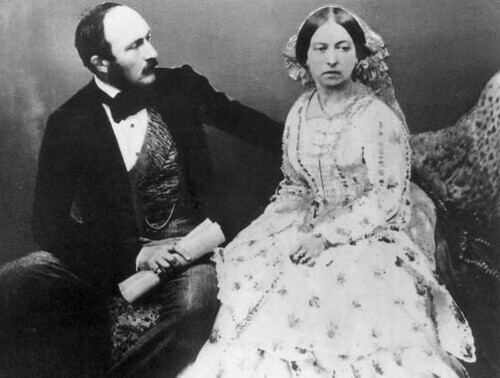 Queen Victoria and Prince Albert, 1854. Photo by Roger Fenton.This set in motion feverous activity in candidate cities. In Ottawa, the City Council set up a special meeting of leading citizens, including Sir Richard Scott and Mr. R. J. Friel, to draft a memorial to the Queen setting out Ottawa’s many advantages. Other cities did likewise. Kingston, Montreal and Quebec also sent delegations to London to lobby for support. In the end, Ottawa won the day, a choice favoured by the Governor General. Some say that Ottawa also received unofficial support from Lady Head, the G-G’s wife, who apparently was a good friend of the Queen. The story goes that the Heads had been invited to a picnic lunch in Ottawa held at what would later become Major’s Hill Park. Enchanted with the area and its wonderful river views, Lady Head, an amateur watercolourist, made a number of sketches that she shared with the Queen. Ottawa apparently had other high placed supporters, including Prince Albert, Queen Victoria’s Consort.
Queen Victoria and Prince Albert, 1854. Photo by Roger Fenton.This set in motion feverous activity in candidate cities. In Ottawa, the City Council set up a special meeting of leading citizens, including Sir Richard Scott and Mr. R. J. Friel, to draft a memorial to the Queen setting out Ottawa’s many advantages. Other cities did likewise. Kingston, Montreal and Quebec also sent delegations to London to lobby for support. In the end, Ottawa won the day, a choice favoured by the Governor General. Some say that Ottawa also received unofficial support from Lady Head, the G-G’s wife, who apparently was a good friend of the Queen. The story goes that the Heads had been invited to a picnic lunch in Ottawa held at what would later become Major’s Hill Park. Enchanted with the area and its wonderful river views, Lady Head, an amateur watercolourist, made a number of sketches that she shared with the Queen. Ottawa apparently had other high placed supporters, including Prince Albert, Queen Victoria’s Consort.
The Queen received all the documents by October 1857. After reviewing the material sent to her and consulting with her advisers, she selected Ottawa. Her decision was officially relayed to Canada’s Governor General by Henry Labouchere, the Colonial Secretary, in a letter dated 31 December 1857.
This did not end the debate, however. A motion asking the Queen to reconsider her decision was introduced in July 1858 by the opposition led by The Globe newspaper’s radical editor George Brown. The opposition motion passed the House by a vote of 64 to 50. Then things got really weird. The defeated Conservative-led government of John A. Macdonald and George Étienne Cartier, his Canada East confederate, resigned, howling that the opposition motion was an affront to the Crown. With George Brown and his Canada East ally, Antoine-Aimé Dorion, assuming power, it looked like Ottawa’s hopes to be the capital were to be dashed. But the Brown-Dorion government fell after only four days.
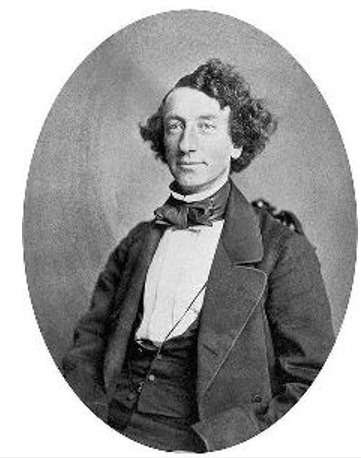 J. A. Macdonald, 1858. Unknown photographer.Under the legislative rules of the day, newly appointed Cabinet ministers were obliged to resign their parliamentary seats and seek re-election before assuming their positions. Brown’s newly minted ministers duly resigned following their appointments. In a snap vote of no confidence, Macdonald and Cartier defeated the new Brown-Dorion administration shorn of its Cabinet ministers. When the Governor General refused to call a general election, Brown resigned, and Macdonald and Cartier were asked back to form a government.
J. A. Macdonald, 1858. Unknown photographer.Under the legislative rules of the day, newly appointed Cabinet ministers were obliged to resign their parliamentary seats and seek re-election before assuming their positions. Brown’s newly minted ministers duly resigned following their appointments. In a snap vote of no confidence, Macdonald and Cartier defeated the new Brown-Dorion administration shorn of its Cabinet ministers. When the Governor General refused to call a general election, Brown resigned, and Macdonald and Cartier were asked back to form a government.
Everybody thought that Macdonald and his new ministers would also resign their seats and seek re-election, leaving the new Conservative government at Brown’s mercy. But, taking advantage of another Parliamentary rule that allowed ministers to change portfolios within a 30-day period without having to seek re-election, Macdonald simply appointed the ministers in his old government to different Cabinet posts before reshuffling them back to their original positions. Macdonald, temporarily Postmaster General, ended up as Deputy Premier rather than Premier in the new government. It seems that the Governor General was worried about the optics of Macdonald regaining the premiership and insisted that Cartier become Premier, at least officially. This sneaky, or brilliant (depending on your point of view), political manoeuvre became known as “The Double Shuffle.” With Brown-Dorion out and MacDonald-Cartier back in, Ottawa’s prospects were restored.
There was one more vote to ratify Queen Victoria’s decision. Held in early 1859, the vote in favour of Ottawa squeaked through with a majority of only five votes.
Sources:
City of Ottawa, 2014. A Virtual Exhibit: Ottawa Becomes the Capital, http://ottawa.ca/en/residents/arts-culture-and-community/museums-and-heritage/virtual-exhibit-ottawa-becomes-capital-0.
Joseph Edmund Collins, 1883. Life and Times of the Right Honourable Sir John A. Macdonald, Rose Publishing Company, Toronto.
Gwyn, Richard, 2007. The Man Who Made Us: The Life and Times of Sir John A. Macdonald. vol 1: 1815-1867. Random House Canada.
Hamnett P. Hill, K.C., 1935. “The Genesis of our Capital,” Bytown Pamphlet Series #3, Ottawa Historical Society.
The Ottawa Evening Citizen 1925. “How Ottawa Was Chosen The Capital of The Dominion,” 25 June.
——————, 1930. “When Queen Victoria Made Ottawa Capital,” 22 May.
Public Works and Government Services Canada, 2013. “Parliament Hill, Pre-construction, 1826-58,” http://www.tpsgc-pwgsc.gc.ca/collineduparlement-parliamenthill/batir-building/hist/1826-1858-eng.html.
Image: J. A. Macdonald, 1858, unknown, File:John A Macdonald in 1858.jpg - Wikipedia
Image: Queen Victoria and Prince Albert, 1855, Roger Fenton, http://www.robswebstek.com/2009/04/queen-victoria-prince-albert-1855.html.
Story written by James Powell, the author of the blog Today in Ottawa's History.
Retired from the Bank of Canada, James is the author or co-author of three books dealing with some aspect of Canadian history. These comprise: A History of the Canadian Dollar, 2005, Bank of Canada, The Bank of Canada of James Elliott Coyne: Challenges, Confrontation and Change,” 2009, Queen’s University Press, and with Jill Moxley, Faking It! A History of Counterfeiting in Canada, 2013, General Store Publishing House, Renfrew, Ontario. James is a Director of The Historical Society of Ottawa.
Ottawa's Ski Hill
9 December 1965
If Ottawa residents wish to go skiing on a typical winter weekend afternoon, they probably think about heading to the slopes of the beautiful Gatineau Hills in Quebec, the home of Camp Fortune, Edelweiss and Vorlage ski resorts in the Chelsea-Wakefield area, less than thirty minutes from Parliament Hill. Some might venture a bit further to Monte Ste Marie, or even Mont-Tremblant, the latter located 140 kilometres from the capital in the Laurentians. On the Ontario side, Mount Pakenham, found to the south-west of Ottawa near the village of Pakenham, provides good family fun. Calabogie Peaks, located “in the heart of the Ottawa Valley” slightly more than an hour’s drive from the city, offers slopes for all levels of expertise. Until 1990, there was another possibility, Carlington Hill, located but a hop, skip and a jump from downtown Ottawa, just south of the Queensway. The hill was accessed from Kirkwood Avenue.
A ski resort at this site was the dream of Ottawa developer, John Clifford, the president of City Ski Centres Ltd, who brought the project to Ottawa City Council during the early 1960s, during the tenure of Mayor Charlotte Whitton. But it took almost five years for his dream to become reality. A significant part of the delay was due to Mayor Whitton’s appropriate mistrust of any city deals with developers that did not involve competitive tenders. As it turned out, Clifford’s company was the sole bidder on the contract when it went to public tender.
The site for the ski resort, Carlington Hill, was the location of a former dump. Reportedly, some fifteen feet of garbage had been deposited at is base where fetid water, draining from the hill in springtime, laid stagnant. While the home for frogs and other wild creatures, the area was also known for its noisome odours. On one occasion, a fire sent foul-smelling fumes into the surrounding neighbourhood.
Building the ski hill was a joint venture between the Ottawa’s Recreation Department and Clifford’s company. The Recreation Department of the City of Ottawa paid roughly $50,000 for extensive grading and filling of the site, a small ski lodge at the bottom of the hill, and the planting of trees and other landscaping. Clifford’s company invested another $50,000 for state-of-the-art Larchmont snowmaking equipment, a special Bombardier machine to groom the hill, a high-capacity T-bar lift able to carry 1,400 skiers up the hill every hour, as well as mercury-vapour lighting to permit night-time skiing. Clifford was granted the concession for the ski facility for ten years, with the City receiving five per cent of gross revenue.
Once completed the hill was 500 feet wide, with a vertical drop of 100 feet with a run of 600 feet. The lodge at the bottom of the hill was equipped with a canteen, a ski rental, an equipment room and a first aid room. Clifford boasted that it was “the biggest little ski area in the East.” He hoped that the hill would appeal to mothers with families who found it too difficult to take their children to Camp Fortune. By being right in the heart of Ottawa close to bus lines and with ample free parking, skiing was in reach of everybody. Clifford also opined that the hill would attract a lot of “housewives’ classes.” (This was not an enlightened age!)
At the beginning of December 1965, with temperatures dropping below the freezing point, crews at Carlington Hill began to make snow and groom the hill in preparation for upcoming ski season. On Thursday, 9 December 1965, the ski hill welcomed Ottawa skiers for the first time. Over the following week, employees worked out the kinks in preparation for the hill’s official opening. The price for a half day (four-five hours) or an evening of skiing was $1.50. The hill was open weekdays from 9:00 am to 10:00 pm, closed on Saturday mornings, and open from 1:00 pm to 6:00 pm on Sundays.
Mother Nature looked kindly on Carlington Hill for its official opening day. On the day before officials descended upon it, three inches of fresh snow fell, making perfect ski conditions. At 7:00 pm on Thursday, 16 December, Santa Claus snow-ploughed down the hill with a sack of candy for the hundreds of children waiting with their parents at the bottom. The grand old elf was accompanied by members of the Gatineau Ski Patrol who slowly descended the slope to the tune of Jingle Bells. At 7:30 pm, Mayor Reid cut the ribbon officially opening Ottawa’s newest and only in-town ski hill. Reid declared “Our dreams have come true.” Event organizers experienced a momentary panic just prior to the official launch when the T-bar lift failed owing to a loose bolt that fell into the machinery. Fortunately, embarrassment was avoided when the lift’s engineers quickly repaired it.
In addition to Mayor Reid, also in attendance that first official evening were other members of city council and George Gowling, the vice-president of the development company, who subbed for John Clifford who was out of town on a business trip. Following Reid’s ribbon-cutting speech, the Gatineau Ski Patrollers began a series of intricate, torchlit manoeuvres on the hill which led into five minutes of fireworks. More than 1,000 skiers then took advantage of the free skiing until closing.
Unfortunately, the Carlington ski hill was judged to have been a “colossal flop” during its first year of operation. Warm weather reduced the number of days of skiing and converted the car park, the site of the former dump, into a muddy mire. However, things improved in subsequent years.
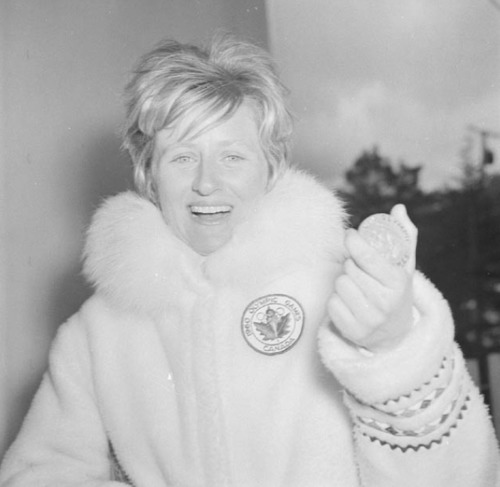 Anne Heggtviet with her gold Olympic Medal, 1960, Squaw Valley, California by E. Ferrat, National Film Board, Library and Archives Canada.In 1969, another ceremony was held when Carlington Hill was re-named the Anne Heggtviet Hill in honour of Ottawa’s ski hero. Anne Heggtviet, nicknamed “Ottawa’s first lady of snows,” was born in the capital and grew up in New Edinburgh. She was the first Canadian to win an Olympic gold medal in skiing, accomplishing this feat at the 1960 Olympic Games held at the now controversially named Squaw Valley, near Lake Tahoe in California. Heggtviet took first place in the slalom, handily beating Betsy Snite of the United States who took the silver medal, and Barbi Henneberger of the “unified” German team who won the bronze medal. (West and East Germany fielded a joint team under a neutral flag—the German tricolour superimposed with the Olympic rings.) In front of a large crowd of her Ottawa friends and family, Heggtviet skied down the hill and broke a ceremonial ribbon. The re-named hill was the second ski slope in the region to be named in her honour. The first one was at Camp Fortune. By now married, and going under the name Mrs Ross Hamilton, she remarked that “The youngsters of Ottawa are lucky to have facilities like this so close at hand.”
Anne Heggtviet with her gold Olympic Medal, 1960, Squaw Valley, California by E. Ferrat, National Film Board, Library and Archives Canada.In 1969, another ceremony was held when Carlington Hill was re-named the Anne Heggtviet Hill in honour of Ottawa’s ski hero. Anne Heggtviet, nicknamed “Ottawa’s first lady of snows,” was born in the capital and grew up in New Edinburgh. She was the first Canadian to win an Olympic gold medal in skiing, accomplishing this feat at the 1960 Olympic Games held at the now controversially named Squaw Valley, near Lake Tahoe in California. Heggtviet took first place in the slalom, handily beating Betsy Snite of the United States who took the silver medal, and Barbi Henneberger of the “unified” German team who won the bronze medal. (West and East Germany fielded a joint team under a neutral flag—the German tricolour superimposed with the Olympic rings.) In front of a large crowd of her Ottawa friends and family, Heggtviet skied down the hill and broke a ceremonial ribbon. The re-named hill was the second ski slope in the region to be named in her honour. The first one was at Camp Fortune. By now married, and going under the name Mrs Ross Hamilton, she remarked that “The youngsters of Ottawa are lucky to have facilities like this so close at hand.”
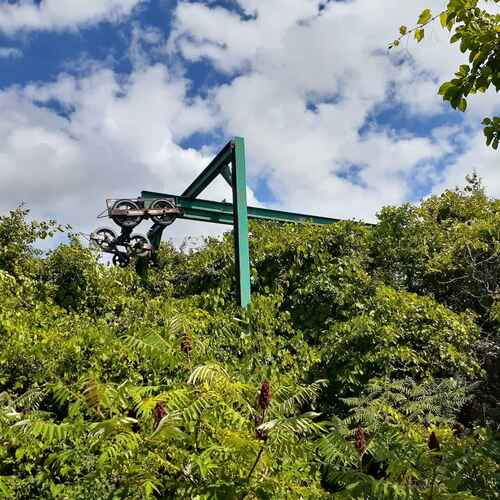 Rusting remains of the ski lift at the Anne Heggtveit Hill, August 2020, by James Powell.The Anne Heggtviet ski hill remained in operation for twenty-five years through to the end of the 1989-1990 ski season. But with declining attendance and aging equipment, the City’s Community Services and Operations Committee took the decision to close the facility. The biggest, little ski area in the East could no longer compete against more challenging, nearby ski resorts. The Anne Heggviet Hill with its 100-foot vertical drop and uninspiring run of only 600 feet was essentially a “bunny hill,” attractive to only the very young or the most novice skiers. Other ski resorts could offer something for all levels of experience. Camp Fortune in Quebec has twenty-five runs or trails, eight lifts, and a vertical drop of 590 feet. Calabogie Peaks boasts twenty-four runs, three lifts, a vertical drop of 780 feet, with a run of 6,961 feet long. The vertical drop of Mont-Tremblant, the greatest of all regional ski resorts, is 2,116 feet. Its longest run is four miles in length.
Rusting remains of the ski lift at the Anne Heggtveit Hill, August 2020, by James Powell.The Anne Heggtviet ski hill remained in operation for twenty-five years through to the end of the 1989-1990 ski season. But with declining attendance and aging equipment, the City’s Community Services and Operations Committee took the decision to close the facility. The biggest, little ski area in the East could no longer compete against more challenging, nearby ski resorts. The Anne Heggviet Hill with its 100-foot vertical drop and uninspiring run of only 600 feet was essentially a “bunny hill,” attractive to only the very young or the most novice skiers. Other ski resorts could offer something for all levels of experience. Camp Fortune in Quebec has twenty-five runs or trails, eight lifts, and a vertical drop of 590 feet. Calabogie Peaks boasts twenty-four runs, three lifts, a vertical drop of 780 feet, with a run of 6,961 feet long. The vertical drop of Mont-Tremblant, the greatest of all regional ski resorts, is 2,116 feet. Its longest run is four miles in length.
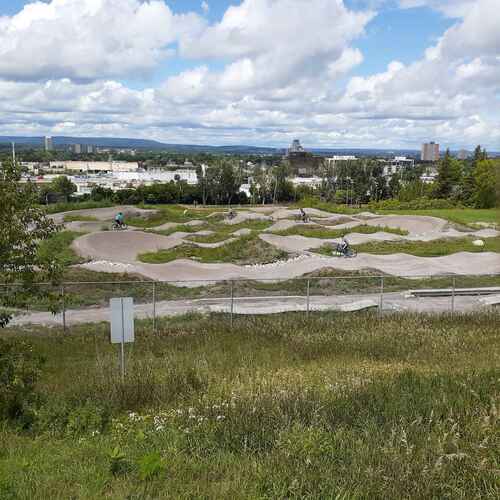 Bike Park at the top of Anne Heggtveit Hill, August 2020, by James Powell.Today, reminders of the Ann Heggtviet Hill’s skiing past can still be seen in the old tow equipment slowly rusting away. But the hill remains one of the city’s premier winter sports locations. Instead of downhill skiers, it draws hundreds of tobogganers on a winter day when snow conditions are just right. In 2020, a bicycle park opened at the top of the old ski hill despite neighbourhood opposition upset about the likely impact of the facility on wildlife and the area’s tranquility. Fortunately, the toboggan hill was not affected.
Bike Park at the top of Anne Heggtveit Hill, August 2020, by James Powell.Today, reminders of the Ann Heggtviet Hill’s skiing past can still be seen in the old tow equipment slowly rusting away. But the hill remains one of the city’s premier winter sports locations. Instead of downhill skiers, it draws hundreds of tobogganers on a winter day when snow conditions are just right. In 2020, a bicycle park opened at the top of the old ski hill despite neighbourhood opposition upset about the likely impact of the facility on wildlife and the area’s tranquility. Fortunately, the toboggan hill was not affected.
Sources:
Boddy, Sharon, 2016. A Jewel In Ottawa’s West: The Carlington Ski Hill,” 23 September, https://sharonboddy.wordpress.com/2016/09/13/715/.
Kinsella, Jack. 1965. “Dreams of four years at Carlington Hill,” Ottawa Citizen, 15 December.
Ottawa Citizen, 1965. “Carlington ready to open,” 8 December.
——————, 1965. “Conditions now ‘very good,” 15 December.
——————, 1965. “Colorful Carlington ski opening,” 17 December.
Ottawa Journal, 1965. “Spectacular Opening For Carlington Ski Centre,” 8 December.
——————-, 1965. “Carlington Ski Centre,” 16 December.
——————-, 1965. “Carlington Park Ski Centre Opens Tonight,” 16 December.
——————-, 1965. “Open $100,000 Ottawa Ski Site—Hint at Green’s Creek Development,” 17 December.
——————-, 1965. “The Sportspiel,” 18 December.
——————-, 1966. “Carlington Ski Park Was a Colossal Flop,” 16 April.
——————-, 1969. “to Name Carlington Slope for Anne Heggtveit,” 18 December.
Story written by James Powell, the author of the blog Today in Ottawa's History.
Retired from the Bank of Canada, James is the author or co-author of three books dealing with some aspect of Canadian history. These comprise: A History of the Canadian Dollar, 2005, Bank of Canada, The Bank of Canada of James Elliott Coyne: Challenges, Confrontation and Change,” 2009, Queen’s University Press, and with Jill Moxley, Faking It! A History of Counterfeiting in Canada, 2013, General Store Publishing House, Renfrew, Ontario. James is a Director of The Historical Society of Ottawa.
Ottawa the Beautiful: The Gréber Report
18 November 1949
Ottawa is undoubtedly a beautiful city. Blessed by geography, the city borders the mighty Ottawa River, and is bisected by the Rideau River and the Rideau Canal, one of only eight UNESCO world heritage sites in Canada. Reputedly, Ottawa has 8 hectares (20 acres) of parklands for every 1,000 residents, compared to only 3.2 hectares (8 acres) of green space for every 1,000 Toronto residents, and a miniscule 1.2 hectares (3 acres) for every 1,000 Montréalais. And that’s not counting Gatineau Park that encompasses 361 square kilometres (139 square miles) of rolling hills and pristine lakes, and extends close to the centre of Gatineau, Quebec, just a few minutes’ drive from Parliament Hill.
Befitting a capital city, Ottawa can also boast magnificent governmental, cultural, and historic buildings and monuments. The National Capital Commission’s “Confederation Boulevard,” which is bordered with broad, tree-line sidewalks, runs along Sussex Drive and down Wellington Street before looping across the Ottawa River and along rue Laurier in Gatineau before returning to Ottawa. On this ceremonial route, one can find the stately homes of the Governor General and the Prime Minister, Canada’s National Gallery, the War Memorial, the storied Château Laurier Hotel, and the Canadian Museum of History. Of course, the crown jewels of the route are Canada’s iconic Gothic Revival Parliament buildings on Wellington Street, perched on a bluff overlooking the Ottawa River.
While a beautiful and extremely livable city, Ottawa is not without blemish. Sparks Street, once the commercial heart of the city, hardly beats these days, while parts of Bank and Rideau Streets are tired and shop-worn. And let’s not talk about LeBreton Flats. But Ottawa is redeemed by its parks and gardens, flourishing neighbourhood communities, thriving markets, and leafy parkways that border its waterways.
Not that long ago, however, Ottawa was a grim, dirty, industrial town; crumbling buildings and blighted neighbourhoods were but a short distance of the Parliament buildings. During World War II, most of the downtown green spaces was filled with “temporary” wooden office buildings hastily constructed to house the Capital’s burgeoning civil service. The city’s natural beauty was also threatened with unplanned urban sprawl, while its waterways were fouled by the detritus of the area’s extensive wood-products industry and the untreated sewage of its mushrooming population.
Efforts to improve the city began shortly after Confederation with the creation of Major’s Hill Park in 1874. In 1899, three years after Prime Minister Sir Wilfrid Laurier voiced his desire for Ottawa to become the “Washington of the North,” the first city improvement committee called the Ottawa Improvement Commission (later the Federal District Commission) initiated a number of landscaping projects, including the Rideau Canal Driveway. A series of urban planning studies were subsequently commissioned, including the Todd Report in 1903, the Holt Commission in 1915, and the Cauchon Report in 1922. Their recommendations included an expansion of Ottawa parklands, the rationalization of the city’s tangle of railway lines, and the enforcement of building regulations. Broadly speaking, however, little was achieved owing to changing government priorities, war, and the Great Depression. One idea that initially found traction but ultimately also failed was the suggestion of forming a National Capital District, akin to the District of Columbia in the United States, that would encompass the cities of Ottawa in Ontario and Hull in Quebec, along with their hinterlands. Political opposition, notably from Quebec, and concerns about the linguistic future of the area’s francophone residents scuppered the idea.
Another effort at rejuvenating Ottawa’s downtown core close to the Parliament buildings began in 1937 under the guidance of Jacques Gréber, a noted French urban planner whom Prime Minister Mackenzie King had met at the Paris Exhibition (Exposition Internationale des Arts et Techniques dans la Vie Moderne) held that same year. Gréber had been the Chief Architect of the Exhibition. When the two men hit it off, King asked Gréber to come to Ottawa to help prepare long-term plans for the development of government buildings along Wellington Street and in adjacent areas. However, war broke out before much could be achieved beyond the construction of the National War Memorial at the intersection of Wellington and Elgin Streets.
Immediately following the end of World War II, Mackenzie King invited Gréber back to Ottawa to head a far larger urban planning project—devising a long-term development plan for the entire 2,300 square kilometre (900 square miles) National Capital Region. Gréber was a controversial choice. The Royal Architectural Institute of Canada objected, writing a letter to Mackenzie King saying that the National Capital development project should have been entrusted to a group of Canadian specialists rather than to a foreigner. Officially, responsibility for the project rested with the 17-member National Capital Planning Committee composed of representatives of the cities of Ottawa and Hull and area counties, the chairman of the Federal District Commission (FDC), the Federal Minister of Public Works, Canadian professional institutes, including the Royal Architectural Institute of Canada, and others. While Gréber was clearly the lead consultant, he was supported by the FDC and a staff of Canadian architects and engineers.
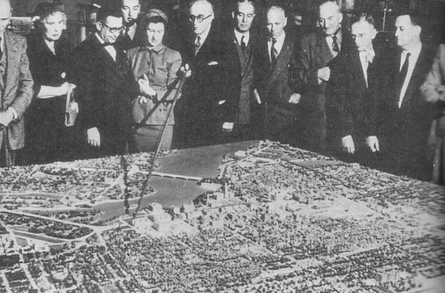 Jacques Gréber shows off the model of his plan for the National Capital to Members of Parliament, 30 April, 1949.The final 300-page report, along with the accompanying volume of maps, watercolours, and scale model of the city, was released on 18 November 1949 after more than four years of work. Mackenzie King, who had retired as prime minister the previous year, wrote the foreword to the report. In many ways, Gréber’s plan for the National Capital was King’s legacy to the country. The plan was also dedicated as a memorial to Canadian service people who died in World War II.
Jacques Gréber shows off the model of his plan for the National Capital to Members of Parliament, 30 April, 1949.The final 300-page report, along with the accompanying volume of maps, watercolours, and scale model of the city, was released on 18 November 1949 after more than four years of work. Mackenzie King, who had retired as prime minister the previous year, wrote the foreword to the report. In many ways, Gréber’s plan for the National Capital was King’s legacy to the country. The plan was also dedicated as a memorial to Canadian service people who died in World War II.
Before discussing its recommendations and their justification, the Report provided an in-depth survey of the National Capital Region, covering its physical characteristics, history, demographics, land use, housing, public buildings, transportation systems, with a special section on the railways, and recreational/touristic facilities. Sometimes the Report is more poetry than prose, referring, for example, to the “broad bosomed” Ottawa River and the “boisterous leaping Chaudière.” At one point it strays into conjecture, uncritically accepting the unsubstantiated claim that the 1916 fire that demolished the Centre Block on Parliament Hill was “set by a German hand.” Despite such quibbles, the Report is exhaustive, and makes a compelling case for its sweeping urban renewal plans for downtown Ottawa-Hull, and the preservation of rural greenspaces.
The key recommendation was the relocation of the railways and associated rail yards and warehouses out of the downtown core. Gréber argued that the tracks had been laid to serve the interest of their operators and the lumber barons rather than those of the broader community. Originally on the outskirts of the city, the railways had been constructed without regard for future urban expansion. In addition to beautifying the city, their removal would return the city to its citizens by eliminating rail barriers that divided neighbourhoods, improve safety, and speed traffic circulation. Replacing the railways would be a network of highways, urban arteries, and tree-line parkways. Gréber recommended the construction of two new bridges across the Ottawa River on the outskirts of the city that would link the Ontario and Quebec highway systems, one in the west over Nepean Bay at Lemieux Island, and another in the east over Upper Duck Island. Gréber also sought the elimination of Ottawa’s trolleys as their overhead wires and related infrastructure in the downtown core detracted from the beauty and monumental nature of the area.
Other important recommendations included urban renewal for blighted neighbourhoods close to Parliament Hill, such as LeBreton Flats, the elimination of the war-time “temporary” buildings that littered the city, the imposition of strict building regulations to preserve the view of Parliament Hill, and the decentralization of government operations. To address urban sprawl, Gréber recommended that the Government acquire land to build a greenbelt around the city. He also favoured the expansion of Gatineau Park and the preservation of neighbouring forests and rural areas for recreational and touristic purposes. In downtown Ottawa, he recommended the construction of a number of large monumental buildings, including an Auditorium and Convention Centre on Lyon Street between Sparks and Albert Streets, the establishment of a National Theatre on Elgin Street, a National Gallery on Cartier Square, and a National Library on Sussex Street, north of Boteler Street. Noting that, a “capital without a dignified City Hall is a paradox,” Gréber proposed the construction of a new Ottawa City Hall to replace the one destroyed by fire in 1931 but never rebuilt. His proposed building fronted on Nicholas Street with a new bridge across the Rideau Canal at that point. He also recommended relocating Carleton College (the forerunner of Carleton University) to the fields of the Experimental Farm along Fisher Avenue. Finally, in keeping with the idea that the redesigned National Capital Region would be a memorial to Canada’s war heroes, Gréber planned a giant memorial terrace at the southernmost point of the Gatineau Hills with “an imposing panoramic view” of Ottawa.
As one might expect with any such sweeping plan, there was opposition; many of Gréber’s recommendations were rejected or ignored. But the French urban planner got his way on two key recommendations—the relocation of the railways out of downtown Ottawa, and the establishment of a greenbelt. Through land swaps between the FDC and the railways companies, downtown Union Station, which was across the street from the Château Laurier Hotel, was replaced with a new passenger station built south of the city on Tremblay Road. The unsightly, 600 foot long, train shed at Union Station was demolished, and the tracks that ran alongside the Rideau Canal were removed, making way for Colonel By Drive. Similarly, the Ottawa West freight station and tracks at LeBreton Flats were expropriated. Ottawa’s rattling trams with their unsightly overhead wires were also retired in favour of more economical buses. Earning the gratitude of future residents, the Federal Government was also able to push through Gréber’s greenbelt proposal south of the Capital, despite opposition from suburban townships—Nepean politicians called the greenbelt the “weed belt.”
On other issues, Gréber was less successful. His idea of a huge war memorial in Gatineau was dropped owing to opposition from veterans who wished to commemorate World War II dead at the National War Memorial in downtown Ottawa. Most of the monumental buildings he planned for the downtown core were never built, or were located elsewhere, though his call for the demolition of the “temporary” war-time office buildings was heeded, albeit over a very long time, with the last one—the Justice Annex to the east of the Supreme Court building—only succumbing to the wrecking ball in 2012. His attempt to preserve the view of Parliament Hill from the south through height restrictions on commercial buildings also failed as high-rise office buildings, constructed to house federal civil servants, blocked the view. Similarly, his attempt to rejuvenate the LeBreton Flats took more than a generation to get underway owing in part to changing government priorities and inertia. Fifty years after the blighted neighbourhood was demolished, it remains a work in progress.
With hindsight, Gréber’s preference for the automobile over trains and trams, also had its downside, in part because he grossly under-estimated the expected future population of the National Capital Region. He had anticipated a population on the order of 500,000-600,000 by 2020, compared to 1.4 million today. Like the railways that preceded them, highways and major urban arteries came to divide neighbourhoods. A case in point is the Queensway which replaced the east-west CN rail line; Gréber had envisaged a tree-lined boulevard. Many mourn the loss of a downtown train station, and the passing of the city’s tram lines. The failure to build two new bridges across the Ottawa River at the city’s periphery linking the Ontario and Quebec highway systems has meant that interprovincial traffic continues to be routed across downtown bridges, aggravating traffic woes. Finally, the development of the greenbelt did little to stop urban sprawl as Gréber had hoped. Instead of the greenbelt promoting the development of self-contained satellite communities as he had envisaged, the automobile permitted them to become bedroom communities for Ottawa, and in the process further contributed to traffic congestion.
In sum, the Gréber Plan was marred by faulty assumptions and inadequate follow-through. But, despite all, Ottawa was transformed from a grimy, industrial city to a capital Canadians can be proud of. For that, we must give a big hand to the vision of Jacques Gréber.
Sources:
Butler, Don, 2012. “Putting things back on track for Ottawa’s train station,” 27 May, The Ottawa Citizen, http://www.ottawacitizen.com/news/Putting+things+back+track+Ottawa+train+station/6690940/story.html.
City of Ottawa, 2010-15. Relocating the Rail Lines, http://ottawa.ca/en/residents/arts-culture-and-community/museums-and-heritage/witness-change-visions-andrews-newton-6.
Gordon, David. 2000. Weaving a Modern Plan for Canada’s Capital: Jacques Gréber and the 1950 Plan for the National Capital Region, https://qshare.queensu.ca/Users01/gordond/planningcanadascapital/greber1950/Greber_review.htm.
Théoret, Huger, 2013. “Le plan Gréber dévoilé aux Communes,” Le Droit, 8 mars.
NCC Watch, 2003(?). NCC Blunders: Ottawa’s Union Station, http://nccwatch.org/blunders/unionstation.htm.
The Ottawa Citizen, 1945. “Canadian Architectural Institute Protest Hiring of Jacques Greber,” 2 October.
———————-, 1945. “Jacques Greber Arrives to Plan National Capital,” 2 October.
National Capital Planning Committee, 1950. “Plan for the National Capital,” (The Gréber Report), https://qshare.queensu.ca/Users01/gordond/planningcanadascapital/greber1950/index.htm.
Macleod, Ian, 2014. “The lost train of nowhere,” The Ottawa Citizen, 18 December, http://ottawacitizen.com/news/local-news/from-the-archives-the-lost-train-of-nowhere.
Images:
Intersection of Wellington Street and Lyon Street, looking south, 1936, the Gréber Report, Illustration #153.
Jacques Gréber shows off the model of his plan for the National Capital to Members of Parliament, 30 April, 1949,National Capital Commission, 172-5, http://www.lapresse.ca/le-droit/dossiers/100-evenements-historiques/201303/08/01-4629049-16-le-plan-greber-devoile-aux-communes.php.
Retired from the Bank of Canada, James is the author or co-author of three books dealing with some aspect of Canadian history. These comprise: A History of the Canadian Dollar, 2005, Bank of Canada, The Bank of Canada of James Elliott Coyne: Challenges, Confrontation and Change,” 2009, Queen’s University Press, and with Jill Moxley, Faking It! A History of Counterfeiting in Canada, 2013, General Store Publishing House, Renfrew, Ontario. James is a Director of The Historical Society of Ottawa.



